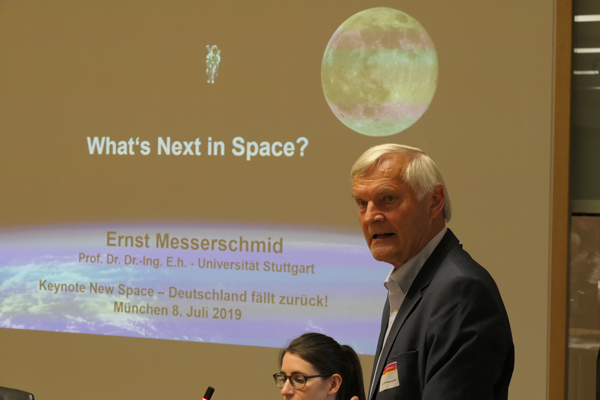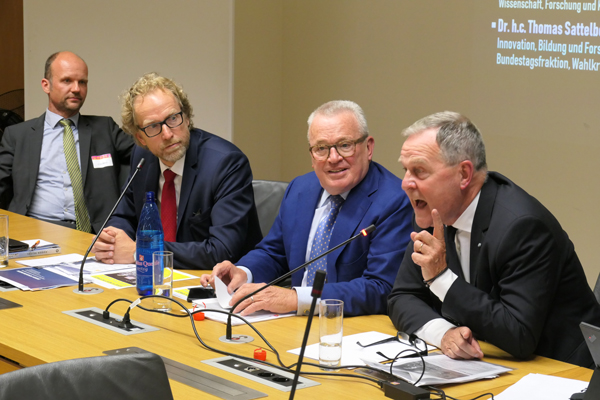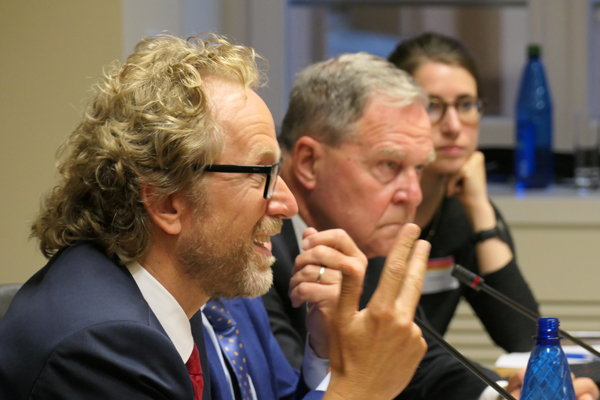Innovative Raumfahrttechnologien live entfaltet und präsentiert.
November 2025

Innovative Raumfahrttechnologien live entfaltet und präsentiert.
November 2025
Am Mittwoch, dem 19. November 2025, empfing die HPS GmbH auf ihrem Messestand der Space Tech Expo 2025 in Bremen den DLR-Raumfahrtchef Dr. Walther Pelzer. Die CEOs und führende Vertreter von HPS München und deren Joint-Venture HPtex Münchberg informierten die hochrangigen Gäste der deutschen Raumfahrtagentur über die neuesten Fortschritte im Bereich der weltraumtechnischen Innovationen.
Im Rahmen des Besuchs wurden den Gästen zwei herausragende Entwicklungen live vorgestellt (siehe Bild):
Beide Technologien wurden zeitgleich und live am Stand als eindrucksvolle Demonstration entfaltet; sie stammen aus renommierten ESA-Technologieprogrammen wie GSTP und ARTES, welche den europäischen Raumfahrtunternehmen als Basis für stetige Wettbewerbsfähigkeit bieten.
HPS und HPtex waren Teil des von @BavAIRia großartig organisierten und schön arrangierten bayerischen Gemeinschaftsstandes.
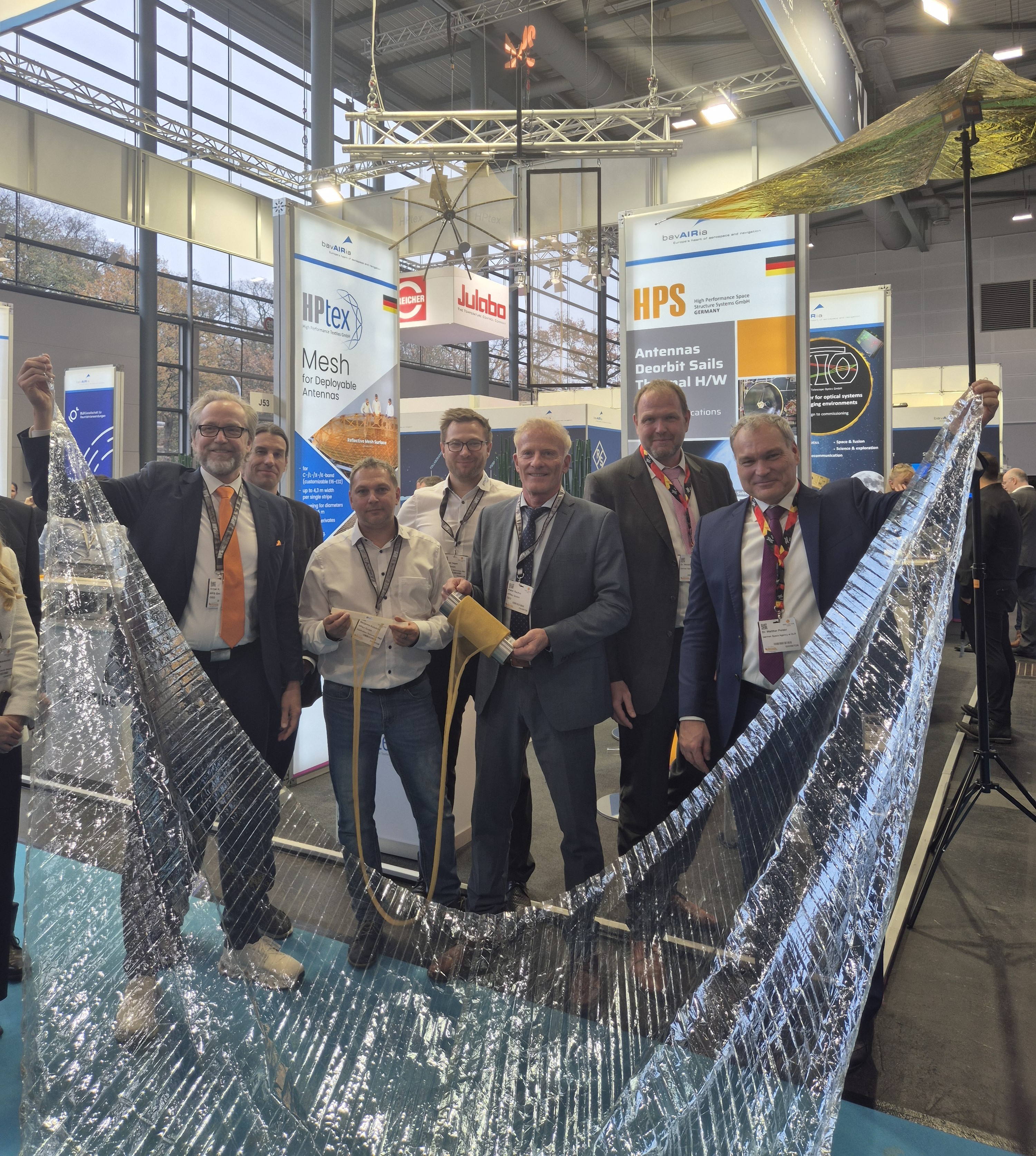
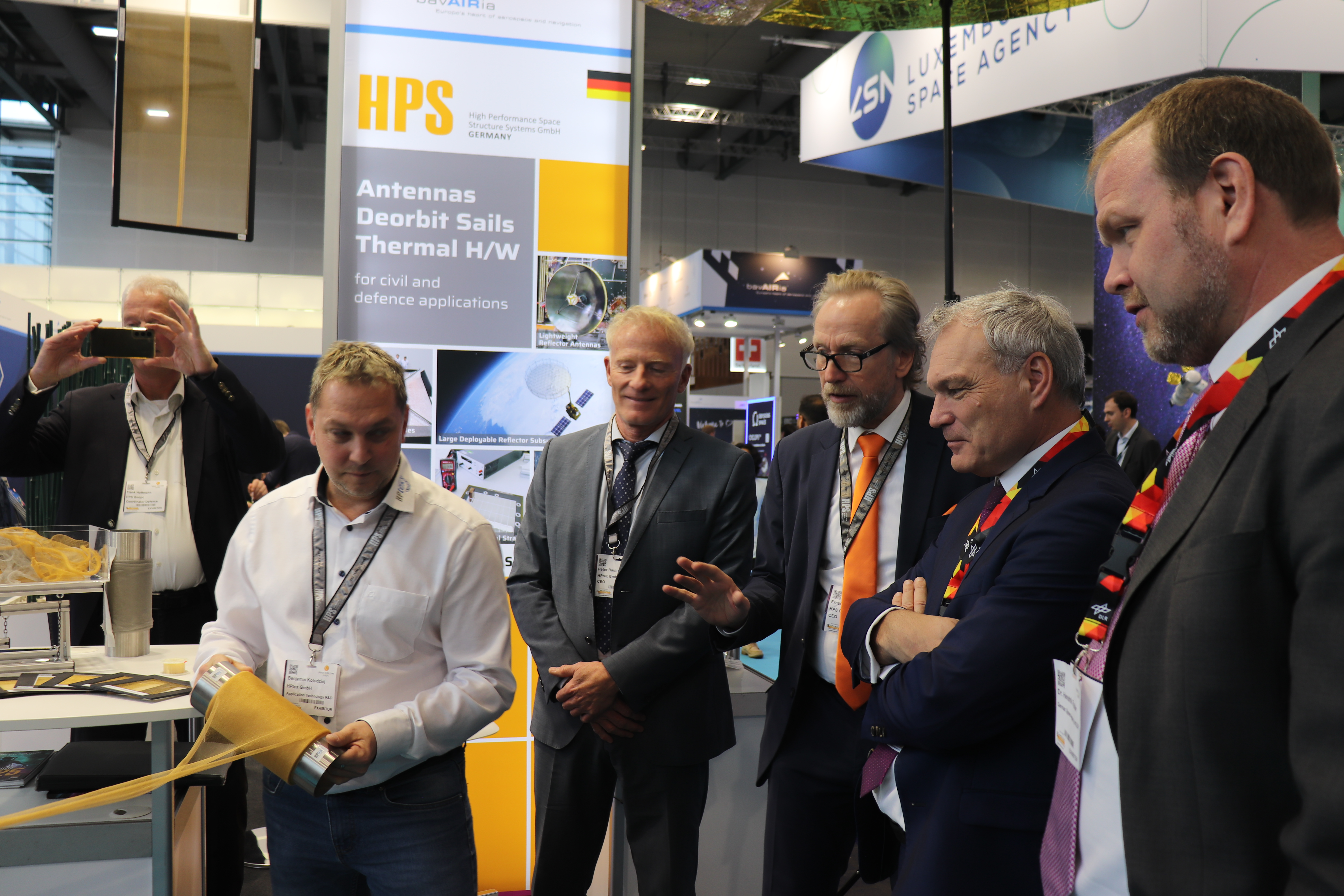
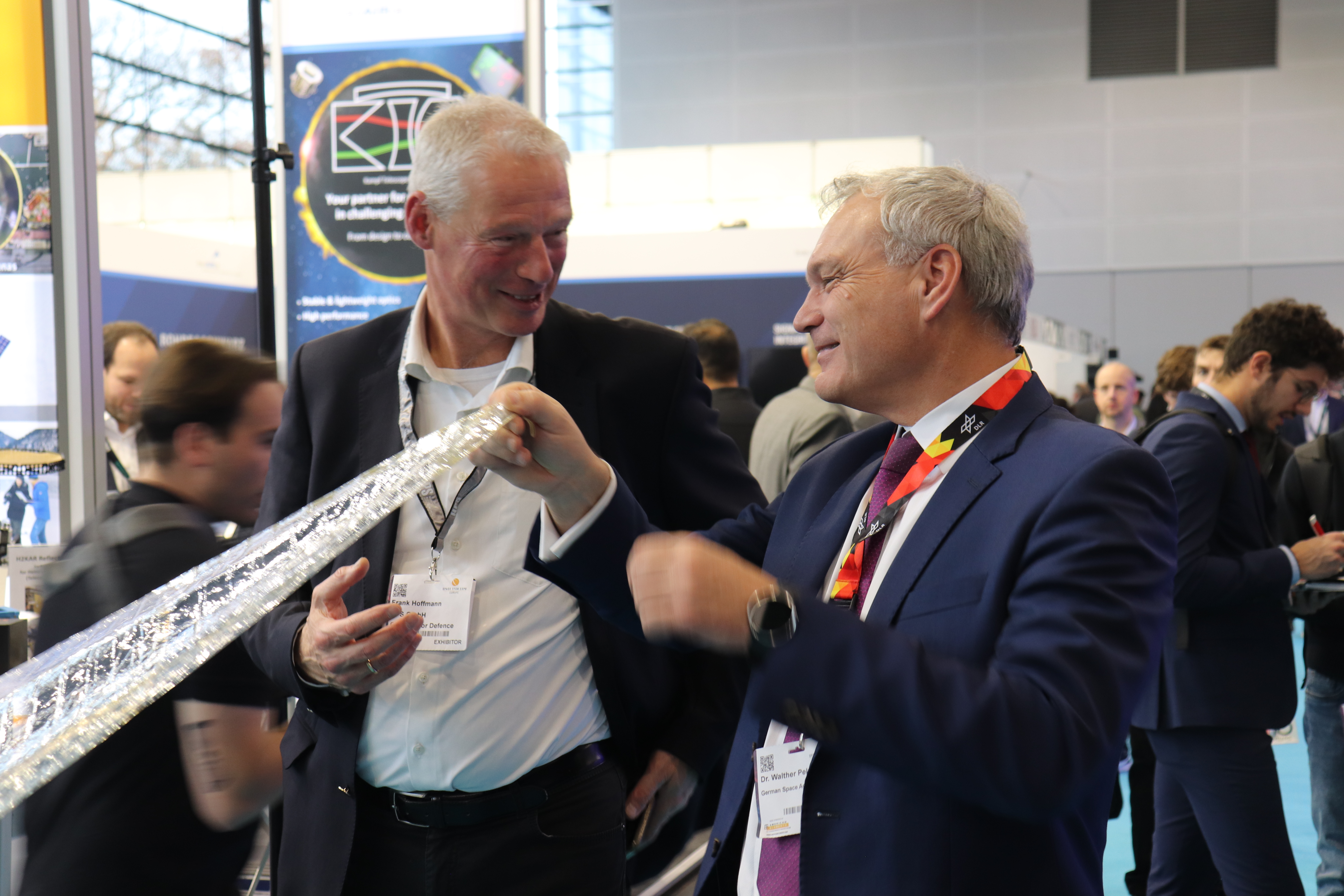
Continuity and commitment to small and medium-sized aerospace companies
November 2025
We are delighted that our managing partner and CEO, Dr. Ernst K. Pfeiffer, was elected spokesperson for the “AKRK – Working Group of German Aerospace SMEs” at the German Aerospace Center (DLR) for the sixth time in a row on November 12, 2025. Dr. Pfeiffer has held this position of responsibility without interruption since 2015 and enjoys a high level of trust and esteem within the industry.The AKRK represents the interests of around 40 leading German aerospace SMEs vis-à-vis key institutions and political decision-makers in Germany and Europe, including at events such as those organized by UNOOSA and the G20. With over 30 years of experience in the space industry, the focus is on a balanced space ecosystem in synergetic cooperation and the confident technological advancement of space travel. The aim is to actively shape the framework conditions for small and medium-sized companies in the industry and to drive forward future-oriented innovations.
Ernst K. Pfeiffer comments: “Being re-elected as spokesperson for German space SMEs is both a great honor and an incentive for me not to slacken my efforts. We are all working hard to create conditions that will strengthen the innovative power and competitiveness of our small and medium-sized enterprises in a resilient and sustainable manner for Germany beyond 2030. Important decisions are being made right now in the last two months of the year: in the run-up to the German 2026 budget decisions and the ESA Ministerial Council meeting, as well as in the Federal Ministry of Defense’s (BMVg) plans for the Bundeswehr’s space architecture. Germany can be proud of its large high-tech aerospace supply industry and its specialized small satellite expertise, and can now catapult itself into a global leadership position for the coming decades through appropriate industrial policy.”
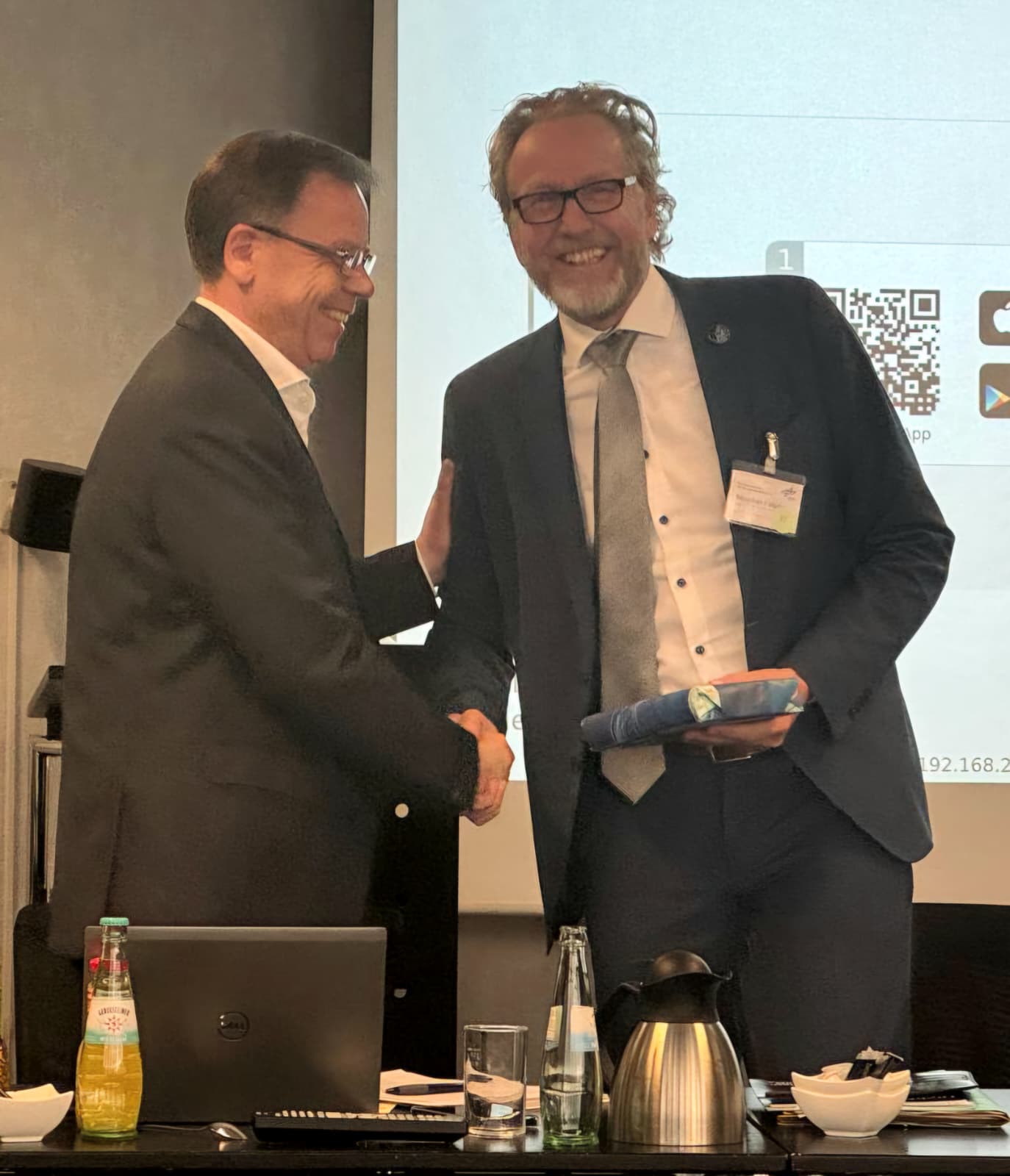
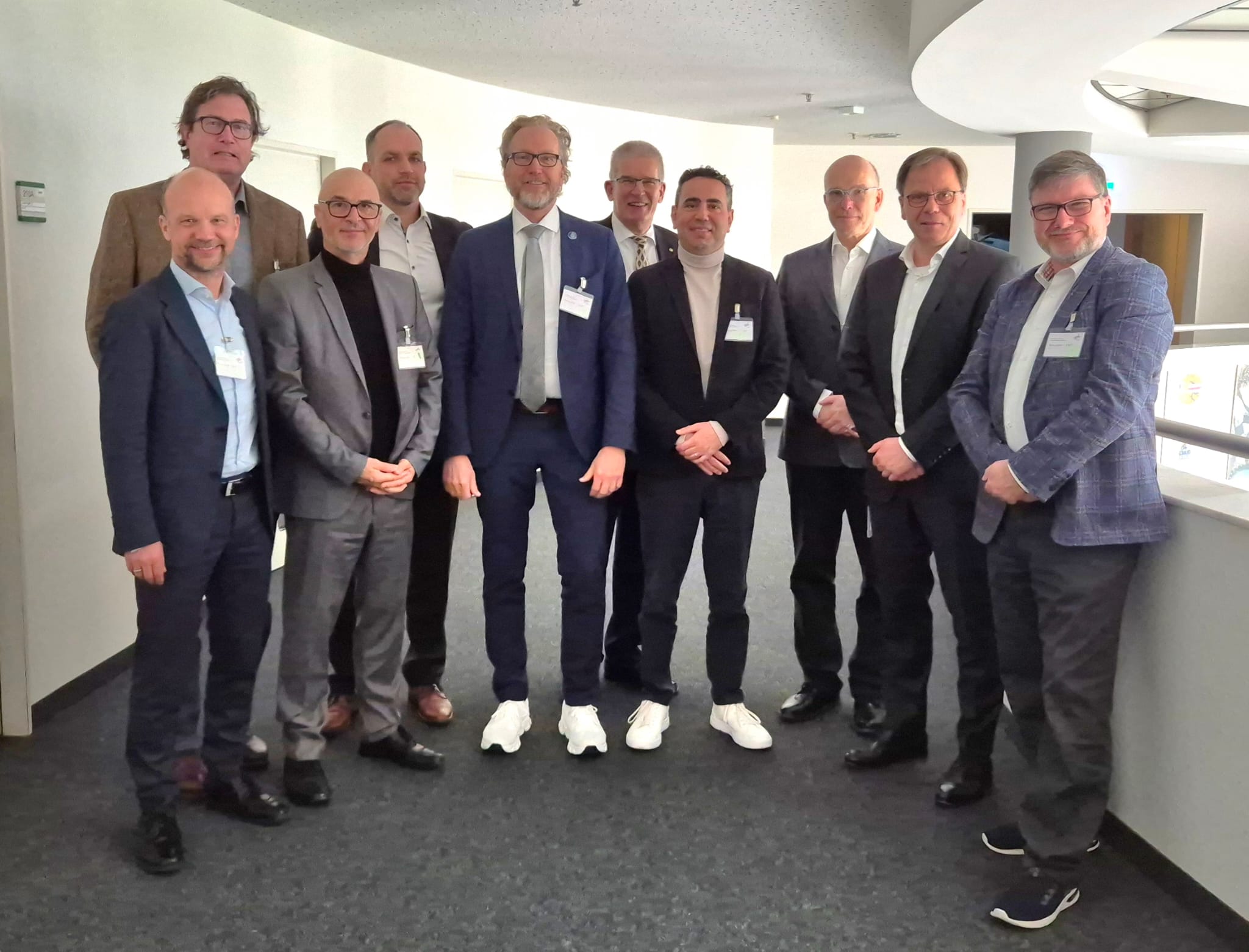
HPS prominently present at ESA’s Zero Debris Week
June 2025
From 10 to 12 June 2025, everything at ESA’s European Space Operations Center in Darmstadt will be dominated by the highly ambitious “Zero Debris Program” of Europe’s space agency. The days are divided into two large action chapters: from June 10-11 at noon, the Zero Debris Future Symposium will focus in particular on high-level discussions of non-technical aspects, such as the future direction of the Zero Debris Initiative and its community, as well as commercial and political challenges in connection with orbital debris. Day two, June 11-12 at noon, will be dedicated to another working session on the Zero Debris Technical Booklet. Among other things, the technical leaders who will oversee the next edition of the booklet will be elected on this occasion. The participating organizations will also discuss how they have used the booklet so far, how the work on the booklet should be regulated and organized, and how the technologies listed in the booklet can be implemented.
The Zero Debris Technical Booklet published on January 15, 2025 lists technologies that ESA believes will contribute to achieving the goal of zero debris by 2030. The booklet is essentially a technical zero debris “to-do list”. The aim is to minimize the release of new debris and reduce its impact on people, infrastructure and the Earth’s environment.
Developed by a team of engineers, operators, lawyers, scientists and policy experts from a wide range of institutions in the Zero Debris community, the booklet identifies six key technology objectives that are essential to achieving Zero Debris goals:
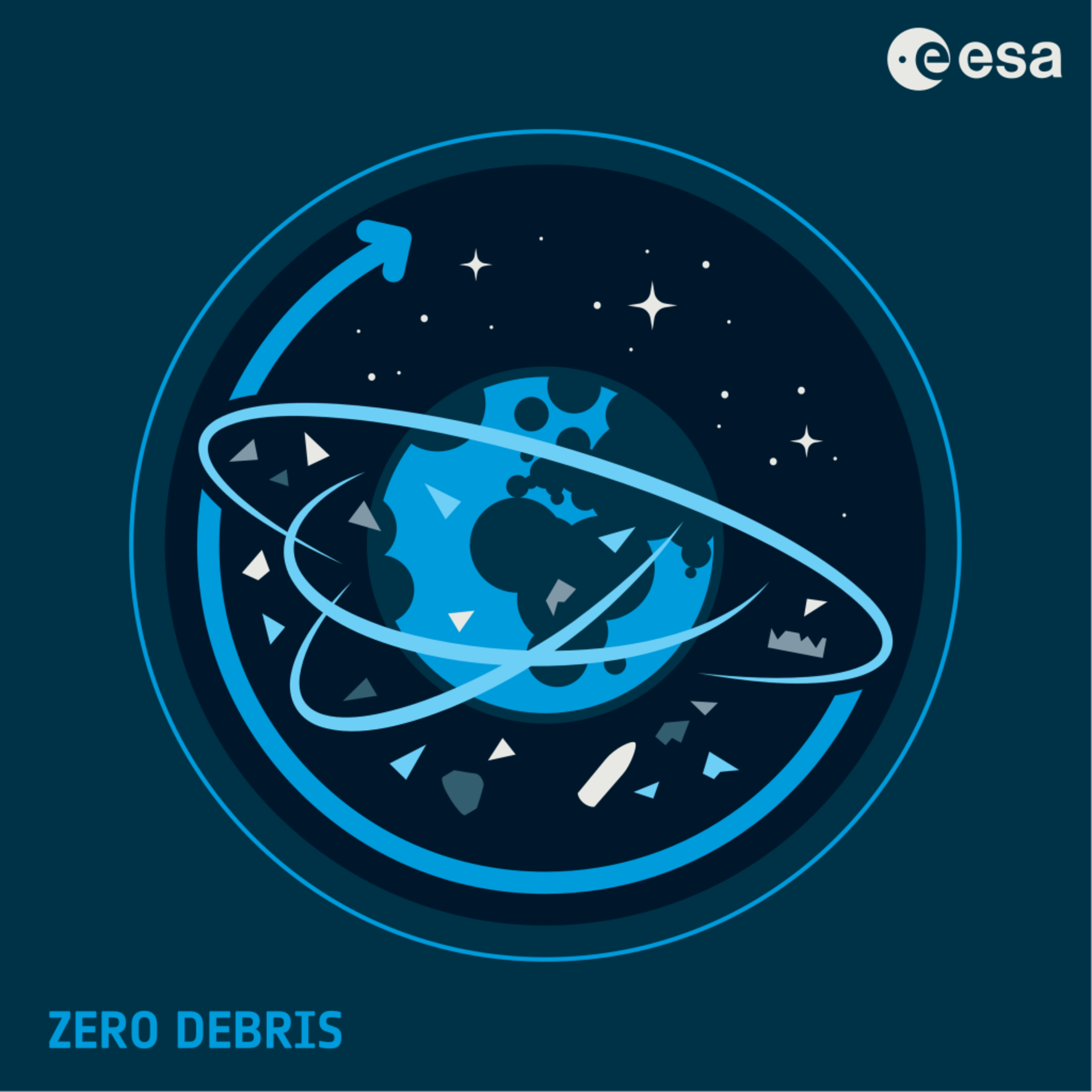
ESA itself is focusing its efforts on the development of debris-resistant materials and technologies, the design of satellites that can be easily removed from orbit and do not burn up on re-entry into the atmosphere, and finally the development of standardized interfaces for efficient removal in the event of a malfunction.
Beyond the satellite itself, the focus is also on new systems to remove all components of the launch vehicle from orbit. Another source of debris are small particles released by certain types of fuel and pyrotechnics in orbit during deployment. Alternatives are to be developed for this. The distribution of space debris around the Earth highlights the importance of collision avoidance measures. Once the satellites are in operation, much can be gained by optimizing collision avoidance processes and space traffic management. A key element is improving tracking capabilities for smaller, currently untrackable debris objects to refine risk assessment.
Operational practices can also be optimized, supported by new technologies to improve communication infrastructure and spacecraft health monitoring. At the end of a mission, the deorbit and re-entry process (for LEO and MEO satellites) and the impact on the environment need to be considered. Active debris removal services are required in orbit, as well as reducing the environmental impact of debris re-entry on the ocean and atmosphere, which will begin with further research.
Participation in ESA’s Zero Debris Initiative is a top priority for HPS – and accordingly, HPS CEO Ernst K. Pfeiffer will take part in the central program items on both days in Darmstadt. HPS’s commitment goes far beyond academic aspects, as the company has already made a remarkable contribution to avoiding space debris with its ADEO Deorbit Module product family by rapidly removing disused satellites from orbit; in addition, it is already on the threshold of Phase B with initial developments for a detector for previously undetectable particles from 0.1 to 10 mm in size called SAILOR.
The HPS boss doesn’t mince his words when it comes to emphasizing the importance of the ESA initiative: “The Zero-Debris Initiative is a start, but we are still a long way to our goal. We still have to reach an important milestone, and that is directly in the minds of the target groups: In parts of the space community, the debris issue is still seen as merely a green nice-to-have topic. This is absolutely wrong: it is an issue of great commercial interest and value, because if the littering of orbits continues at this rate, economically viable activities in space will soon be history – and that so before they have really taken off.”
November 2024
German space agency chief Dr. Walther Pelzer and DLR delegation focus on visit to HPS Group
During the traditional DLR delegation round on the opening day of the Space Tech Expo in Bremen, the head of the German Space Agency at DLR, Dr. Walther Pelzer, focused his attention on SMEs in the German space industry. Special attention was paid to the innovation forge HPS. And it was represented in groups: with HPS Germany (Munich), HPS Romania (Bucharest) and the joint venture company HPtex (Münchberg, Germany).
With reference to pioneering antenna projects such as HERA and EUCLID, company boss Ernst K. Pfeiffer emphasized the leading position Germany has gained in special antennas for space missions. HPS is also positioning itself as a leader in the commercial sector with the successful ADEO braking sail project, which ensures compliance with the new 5-year rule for satellite deorbiting and thus keeps the satellites ready for launch.
In his role as spokesman for German space SMEs, Ernst Pfeiffer also took this opportunity to emphasize the enormous importance of the DLR and ESA’s capability-enhancing technology programmes for SMEs as the innovation backbone of the industry. According to Pfeiffer, the precise promotion of the technological capabilities of SMEs via dedicated competition areas reserved for SMEs is irreplaceable.
Live demonstrations, e.g. of a functional model of the ADEO brake sail or a scaled model of a deployable large antenna reflector, supplemented by product demonstrations from HPS-Romania (e.g. radiator) and from HPtex’s MESH production (e.g. Ka-band mesh sample for use in the Copernicus mission CIMR) rounded off the visit program.
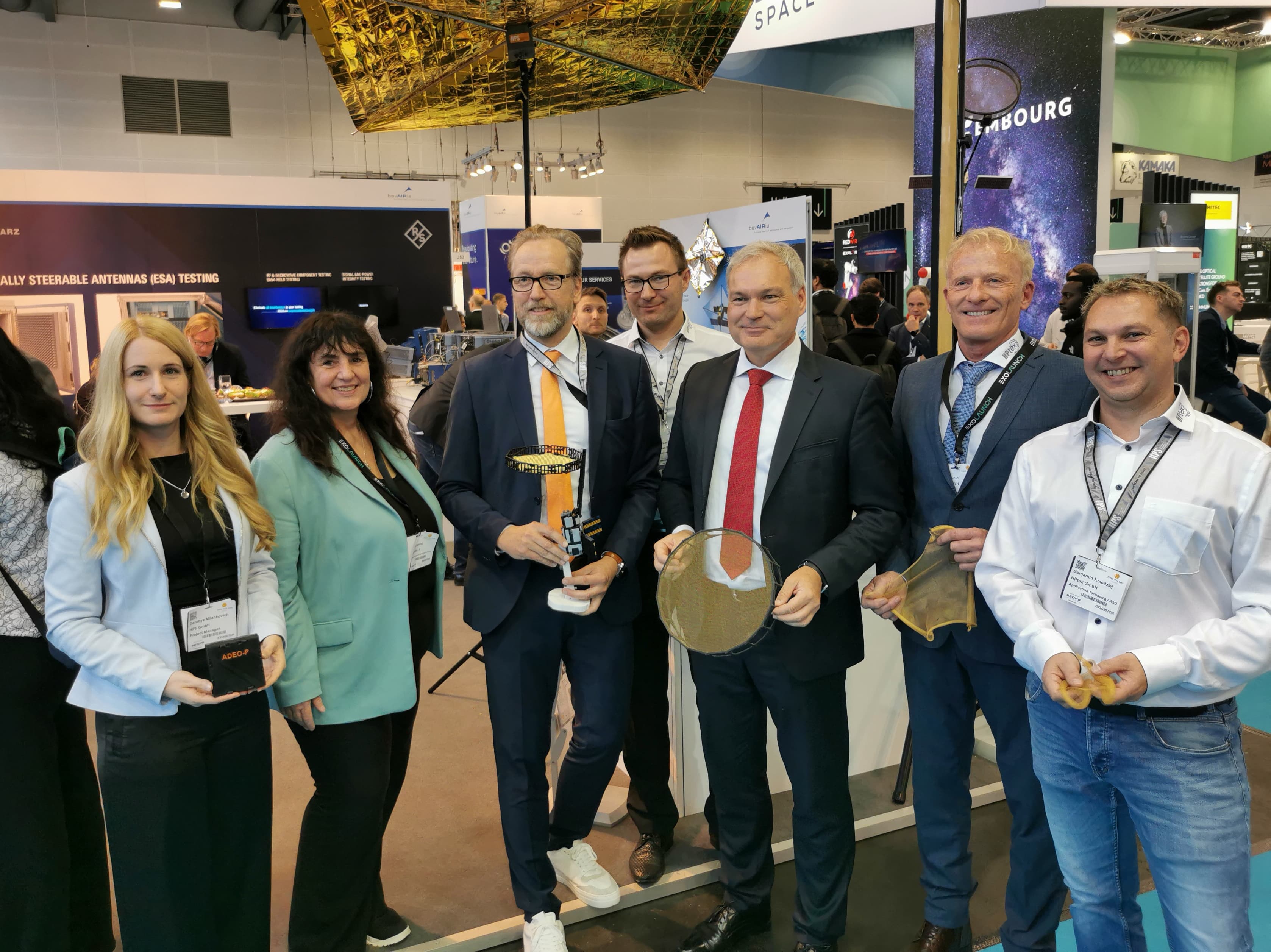
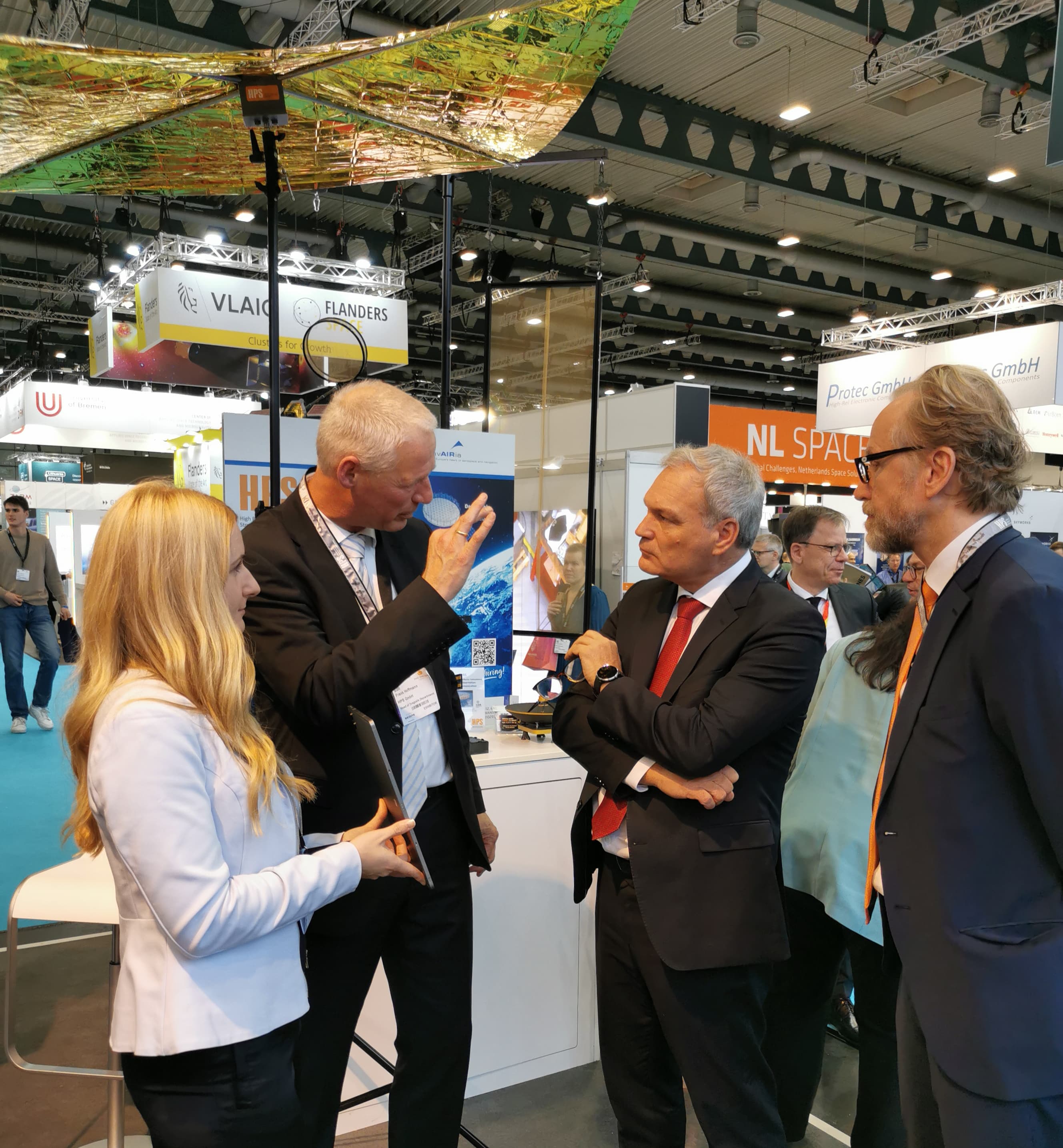
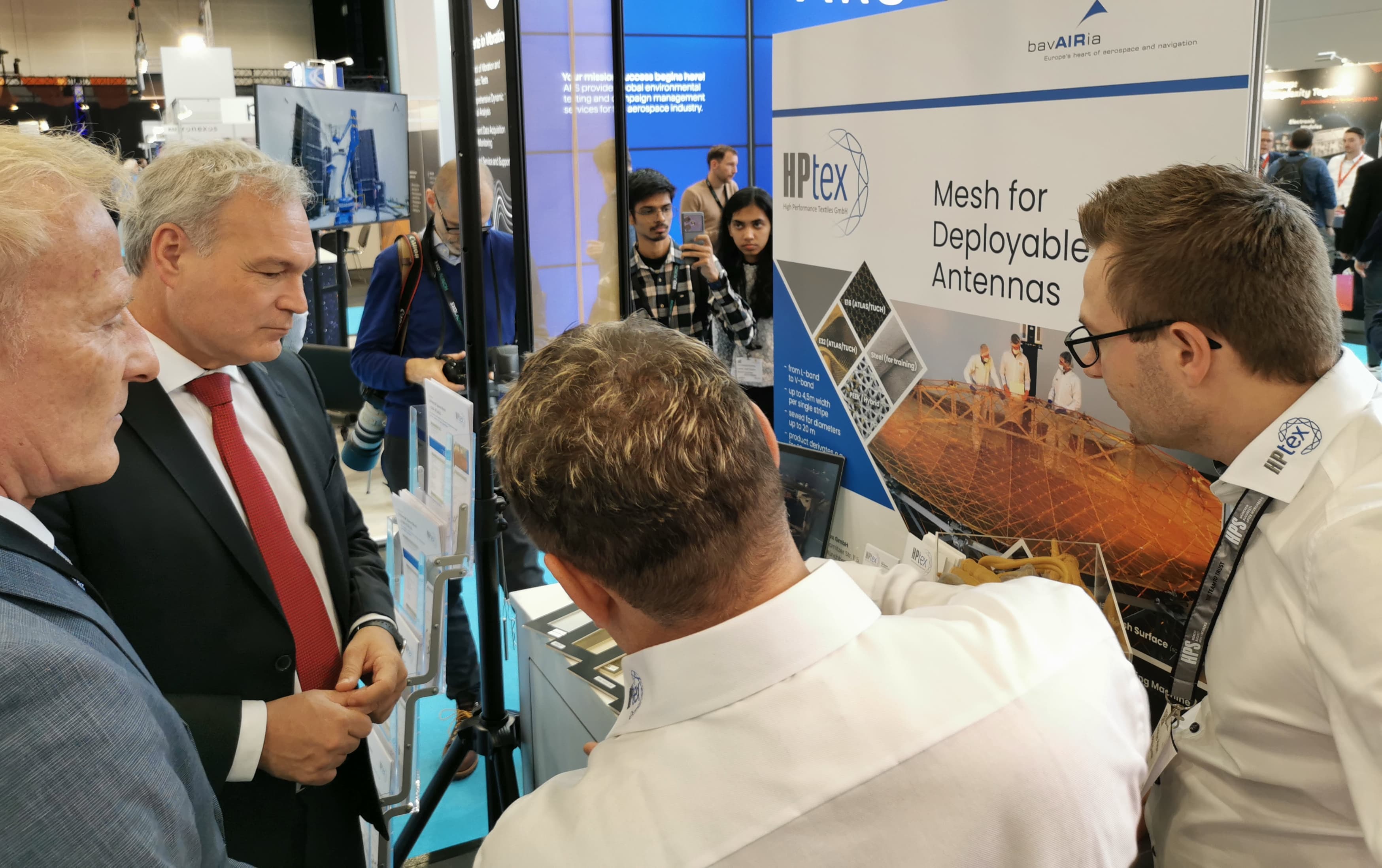
Oktober 2024
HPS Prominently Present at the IAC in Milano
Participating in the International Astronautical Congress, IAC, has developed into a good tradition at HPS over many years. This year, the company will be represented by Ernst K. Pfeiffer, CEO, together with ADEO project manager Mrs. Dorittya Milankowitch from HPS Munich and Horatiu Gheorghe as IAC-contact point for HPS Bucharest with products like secondary structures, thermal hardware and purging equipment. The HPS-team will keep up full presence during all five days of this international event.
Special highlights will be the company presentations; they are going to take place on Friday, 18th, from 10.15 to 10.45 a.m., and also as part of the Company Slam at the booth of the German association BDLI on Tuesday from 13.15 to 13.45 p.m..
Focus of both presentations will be on the product family of the ADEO deorbit sailsystem for automatic disposal of satellites after their end of mission, serving the idea of clean space, sustainability and debris avoidance even from the beginning of the satellite´s journey.
Main products besides ADEO to be asked at our booth: reflector antennas, deployable antennas, large deployable reflector subsystems, mesh, thermal hardware, purging equipment. HPS will warmly welcome there all its customers from both worlds: classic and NewSpace. For a dedicated prearranged business meeting please send a message to Contact@hps-gmbh.com.
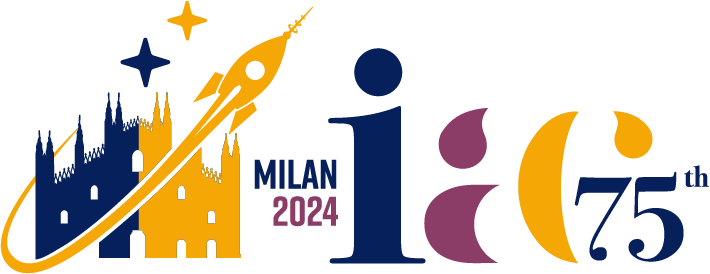
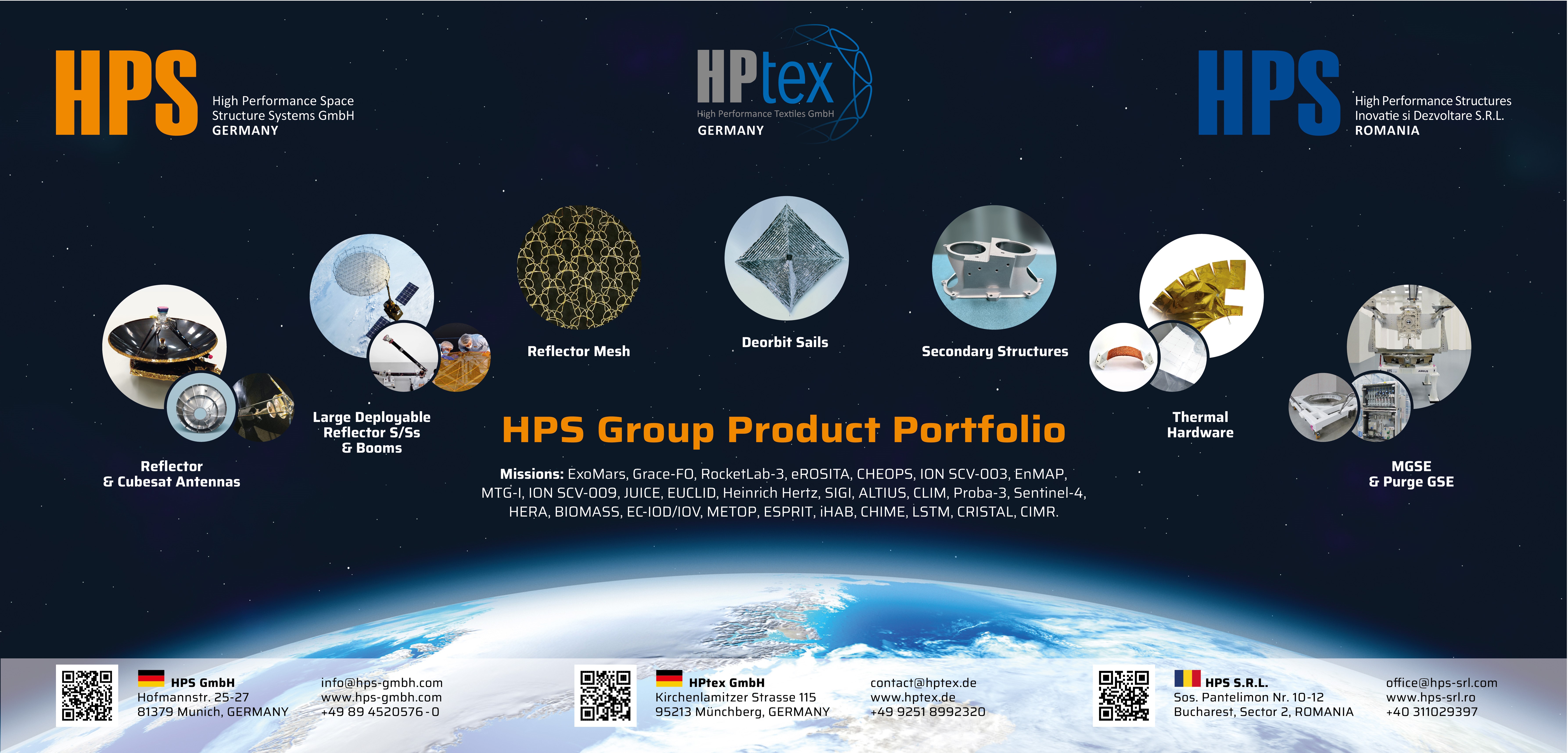
September 2024
HPS with prominent presentation of its whole corporate group at Industry Space Days
Major industry events cast their shadows ahead: The ESA Industry Space Days 2024 will once again take place at the headquarters of the Technology Center of Europe’s space agency ESA in Nordwijk, the Netherlands, from 18 to 19 September 2024. The ISD is organized by the SME Office in the ESA Directorate of Commercialisation, Industry and Competitiveness to foster cooperation between different actors in the entire space sector.
Key elements of the event include:
➔ pre-scheduled 1-on-1 meetings to establish new contacts in an efficient and time-saving manner
➔ an exhibition with ESA and industry booths and the possibility to engage with future partners
➔ keynotes and panel discussions with contributions by ESA, industry, investors and institutional partners
➔ ESA presentations and workshops about business opportunities and future activities.
Once again this year, the European HPS Group will be among the most prominent participants in the event from the space sector of the medium-sized innovation industry. At stand number B25, the Bucharest based specialists from HPS Romania and HPTex GmbH from Münchberg near Bayreuth will be represented under the umbrella of the Munich headquartered HPS – High Performance Space Structure Systems GmbH.
The range of products presented is just as much a testament to the importance that HPS attaches to this industry event as the high-ranking line-up: CEO Dr. Ernst K. Pfeiffer will represent the entire group of companies, Managing Director Astrid Draguleanu will represent HPS Romania and Stefan Bedrich, Head of the Antennas and Structures Department at HPS Munich, will be responsible for large parts of the product portfolio.
At this year’s ISD event, the group of companies will place a particular emphasis on small antennas designed for small missions, alongside HPS’s expertise in deployable antennas.
HPS will also showcase the products of its subsidiary HPTex GmbH, which specializes in weaving reflective mesh suitable for deployable antennas of various sizes and can manufacture stainless steel mesh for the training needs of clients globally.
Meanwhile, at its Bucharest location the HPS Romania primarily produces metal antennas (including 3D printed), secondary structures, thermal hardware (MLI, thermal straps, radiators), MGSE and purge equipment.
All products are designed to be scalable, catering to both large missions and smaller satellites, including cubesat missions.
Nevertheless, the primary focus of HPS at the Industry Space Days 2024 is undeniably on its flagship product, ADEO. This innovative brake sail is generating extraordinary global interest, as it facilitates the automatic and orderly deorbiting of disused satellites of nearly any size, at the end of their missions. ADEO meets all current requirements, essential for obtaining launch authorization on a rocket.
Ernst K. Pfeiffer, who will also be taking part in discussions and meetings in Nordwijk in his other role as spokesperson for the German Space SMEs Association, is looking forward to the wealth of opportunities to focus on personal contact during the two days of the event. He will further expand his own network of customers, suppliers, partners and representatives such as employees from ESA and other institutions and he will promote the strength and power of SME in general and their contribution to the currently happening ESA Transformation.
“For us at HPS, the ESA Industry Space Days are always a very special event highlight. We are delighted to be part of it and would like to thank ESA and all those who plan and set up the event for their commitment.”
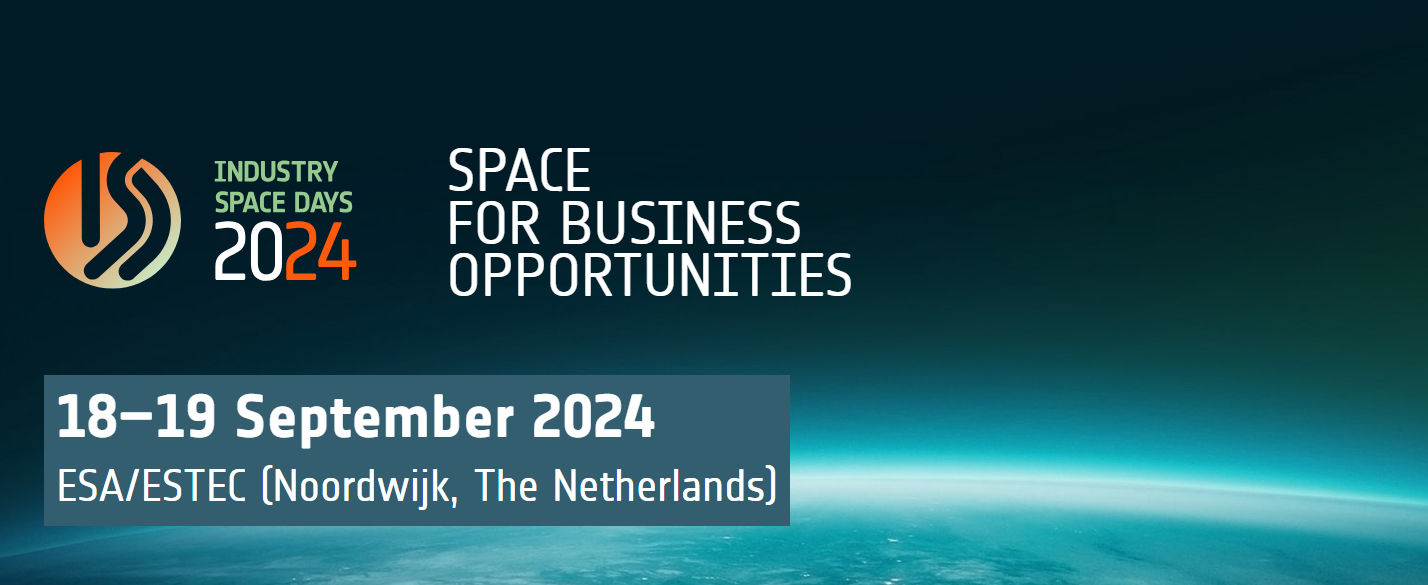

September 2024
Suggestions for ESA Transformation by CEO HPS – HLF 2024
Contribution by Ernst K. Pfeiffer: 7 Points Plan (CEO HPS GmbH and Speaker AKRK German SME). This paper has been created AFTER the HLF-event, taking the handwritten notes prepared BEFORE the event.
Noordwijk, ESA/ESTEC | 10. September 2024
September 2024
DLR’s national SatKom – a reflection of the steady development of HPS into the high-tech forge of the German space industry
It will take place again on September 3 and 4: The national conference “Satellite Communications Conference in Germany”. This is already the eighth event of its kind and reason enough to speak of a successfully established tradition.
In Bonn, leading representatives from industry, research and public clients will discuss satellite communications as an incubator for the information society of tomorrow.
From its premiere in 2008 until today, Munich-based space technology company HPS has remained loyal to the event as an exhibitor and panelist. What began with a modest presentation on “mechanical components for telecommunication” has developed into a central technology showcase for the German medium-sized company, which is now a “gold sponsor” of the event. Among other things, HPS now produces entire antenna subsystems for the most demanding missions and applications. Iconic highlights of German space-tech such as Heinrich Hertz and EUCLID provide impressive proof of the excellence of customized reflector antennas and high-end reflectors on a daily basis.
With HERA, whose complete antenna comes from HPS, will be another contender for the history books of space in October. Reliability and technical excellence – these are the characteristics on which the company builds. This claim is also reflected in the main exhibits on the 12 square meters of the HPS stand in the breadth of a whole range of original hardware:
While the 12 square meters of the exhibition stand are thus reaching their limits, the presentation of HPS’s capacities for the concrete development of further future technologies is only just beginning here; the focus is on
At the booth, HPS CEO Ernst K. Pfeiffer, HPS department head Stefan Bedrich and project engineer Christopher Tapp will be available to contacts from large companies, the German Armed Forces and commercial customers from the NewSpace sector with functional demonstrations of the KEAN manpack antenna and of the ADEO brake sail for accelerated deorbit of decommissioned satellites, which deploys automatically at the end of the mission. In addition, Stefan Bedrich will report on the “Heinrich Hertz North Beam Antenna” and “End-to-end tests with the KEAN deployable backpack antenna” in the lecture program.

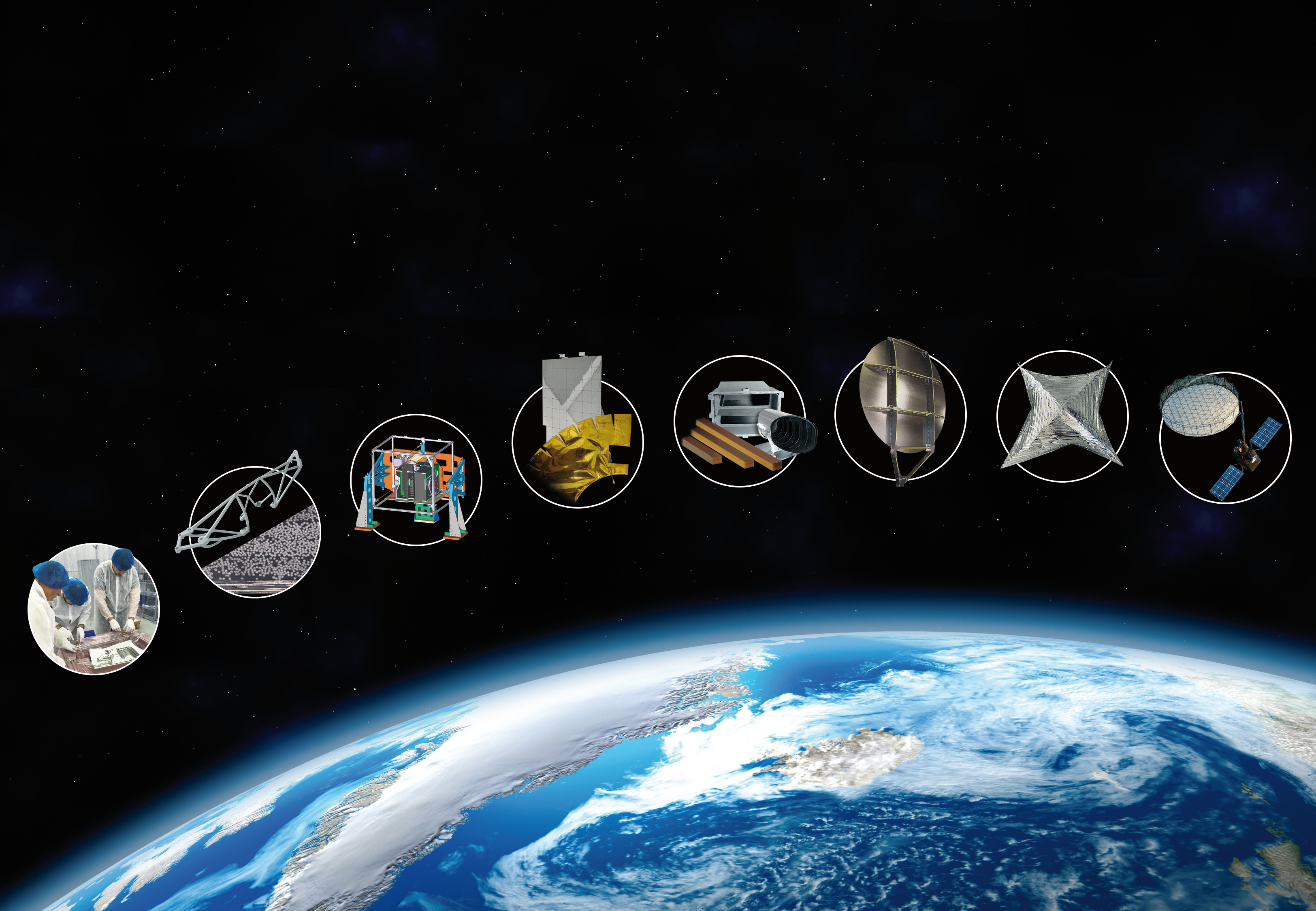
July 2024
HPS CEO as speaker from Europe at the International Day of the Moon in China
On Saturday, July 20, 2024, the fourth International Moon Day, proclaimed for July 20 of each year by the United Nations General Assembly with Resolution 76/76 on “international cooperation in the peaceful uses of outer space”, took place. The physical venue this time was China. Participants came from the United Nations / UNOOSA, the USA, India, Saudi Arabia, Japan and Europe/Germany, among others. Dr. Ernst K. Pfeiffer, CEO of HPS in Munich, had the honour of flying the flag for the latter at this high-level event, which was connected via video link.
He took the floor in Panel 2 on the topic “LUNAR HORIZONS: The Economic Implications of Lunar Exploration and Utilization”, together with Nasr Alsahaaf, Gongling Sun and Satoru Kurosu, moderated by Zhao Chenchen. The video is available here: YouTube. In his triple role as CEO, spokesperson for German SMEs and voice from Europe, Dr. Pfeiffer focused on these key messages: The challenges facing space – and here both SMEs and corporations, European countries such as Germany and Romania – as well as a highly ambitious ESA are as immense as the opportunities.
Radically divergent budget lines of the major continental players reinforce the requirements for models of cooperation, as do the different perspectives that politicians in particular adopt: some see mainly risks, while others see opportunities. Exploiting these opportunities largely depends on the availability of the two main factors: industrial infrastructure and people who can leverage synergies between scientific and commercial exploration. An additional boost to cohesion, despite all cultural and political differences, can come above all from global cooperation on projects such as the exploration and colonization of the moon.
It is equally clear, Pfeiffer told the international plenary session, that more peace between the peoples of the Earth will ultimately lead to more freedom of action and financial budgets in joint planetary exploration. According to Pfeiffer, UNOOSA must play a leading role in this. There are enough topics: space debris, mining rights, space traffic. According to Pfeiffer, the quality and ability to contribute of the many equipment suppliers from Germany will be able to play an important role in solving all problems.
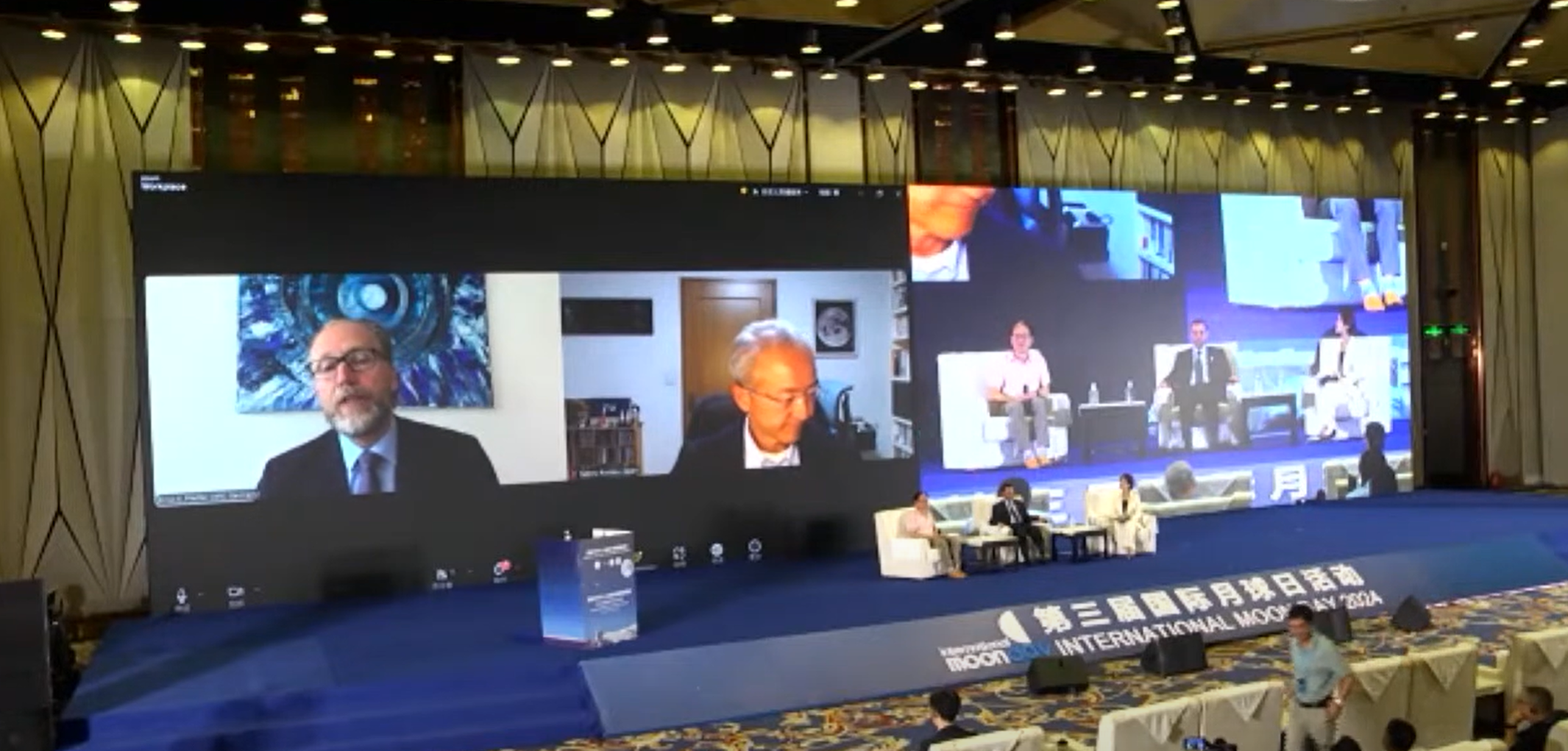
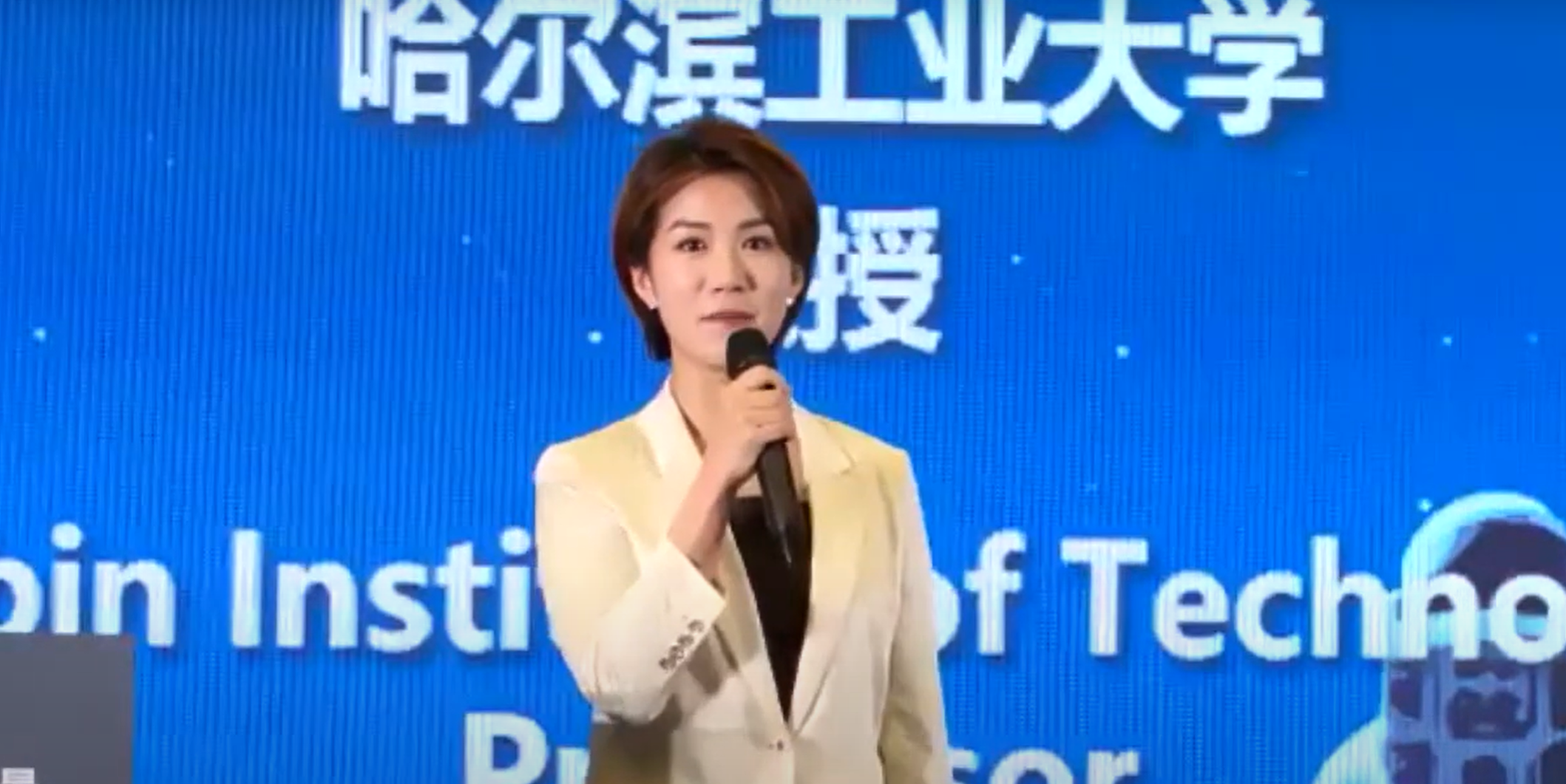
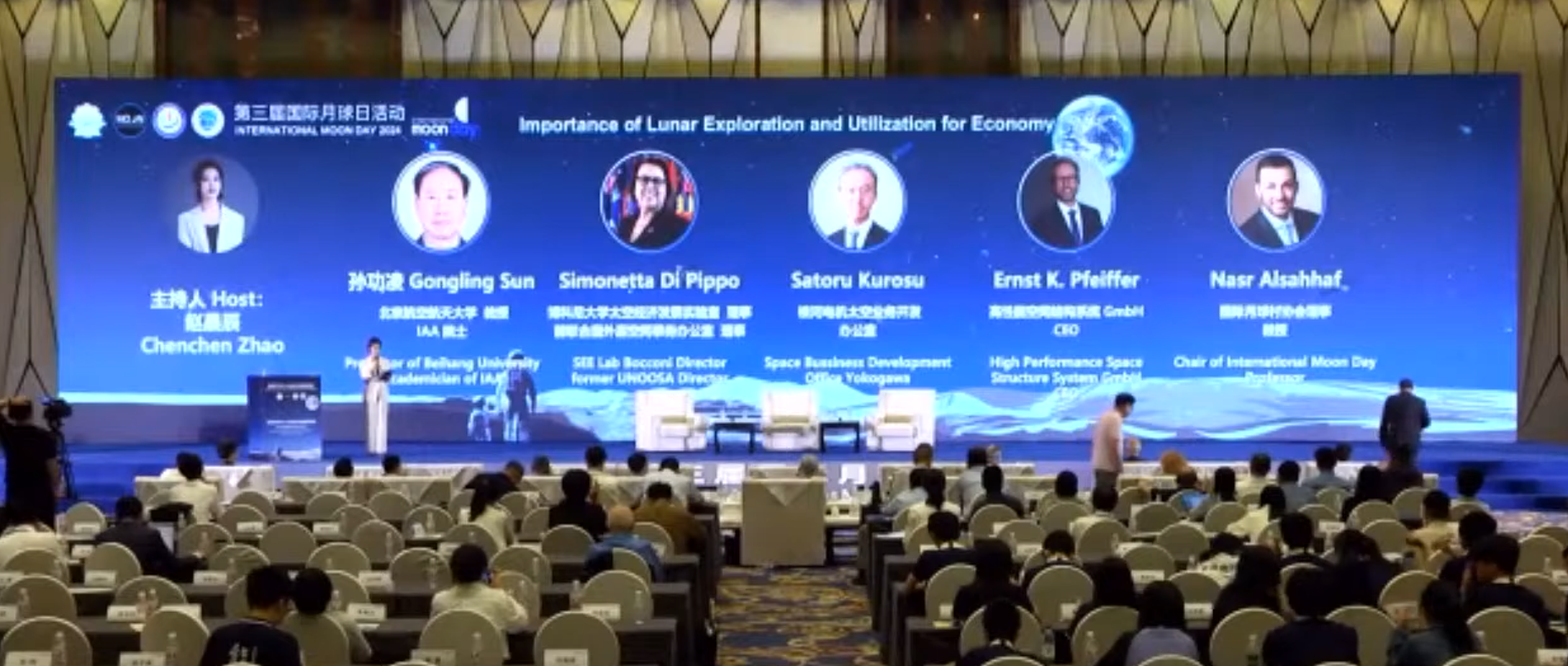
June 2024
ESA Leads the Way: Rapid Implementation of the Zero Debris Charter
Sustainability in space travel has also been an issue for the European Space Agency ESA for years. However, only a few months passed between the decision to adopt a Zero Debris Charter and its implementation.
Keynote speaker ESA Director General Josef Aschbacher also saw this as a sign that the time is finally ripe for concrete steps instead of pure symbolism, especially as ESA itself has provided significant impetus for the development of the two main technologies on the way to “Zero Debris”: firstly, ways of removing scrap from space, but above all, equipping satellites with deorbit technology from the outset so that no more waste is produced after the end of the mission.
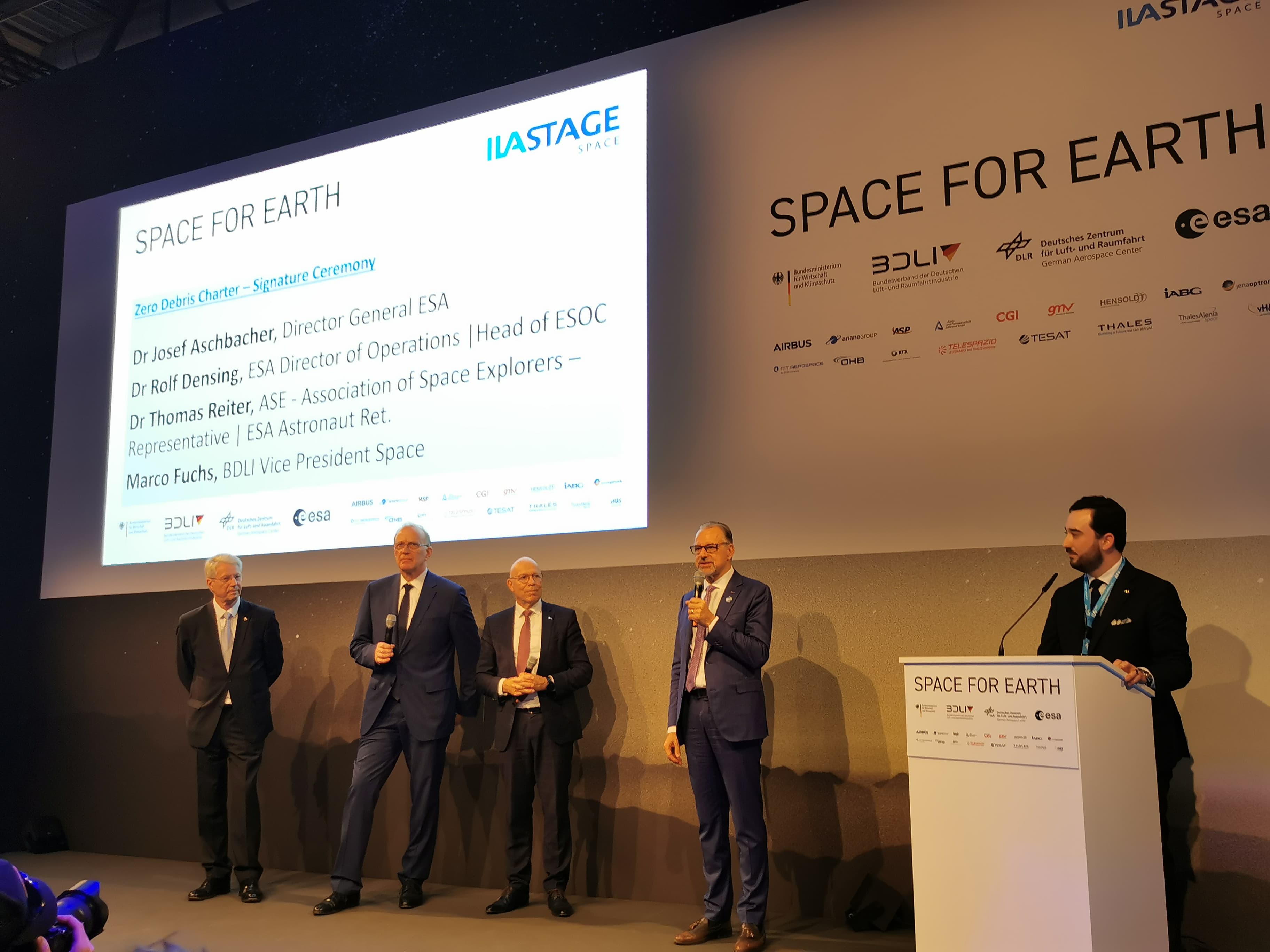
ADEO Drag Sail: The Key to Sustainable Spaceflight
The ADEO brake sail, which is now available as an entire product family for all sizes of LEO satellites from HPS series production, stands for this. In addition to grants and support from ESA, DLR and Bavaria, HPS CEO Ernst K. Pfeiffer also invested a lot of the company’s own money in the project, always firmly convinced that the hour of ADEO would come sooner or later – and if a little later, then all the more powerfully.
It was exactly the same when, in mid-2023, the ESA set the new rule of a deorbit maximum of 5 years for ESA-funded missions instead of the previous 25 years, and, accordingly, LEO satellites without ADEO (or similar) will no longer be launched at all from October 2024, as SpaceX, for example, makes clear in its conditions of carriage in accordance with FCC regulations.
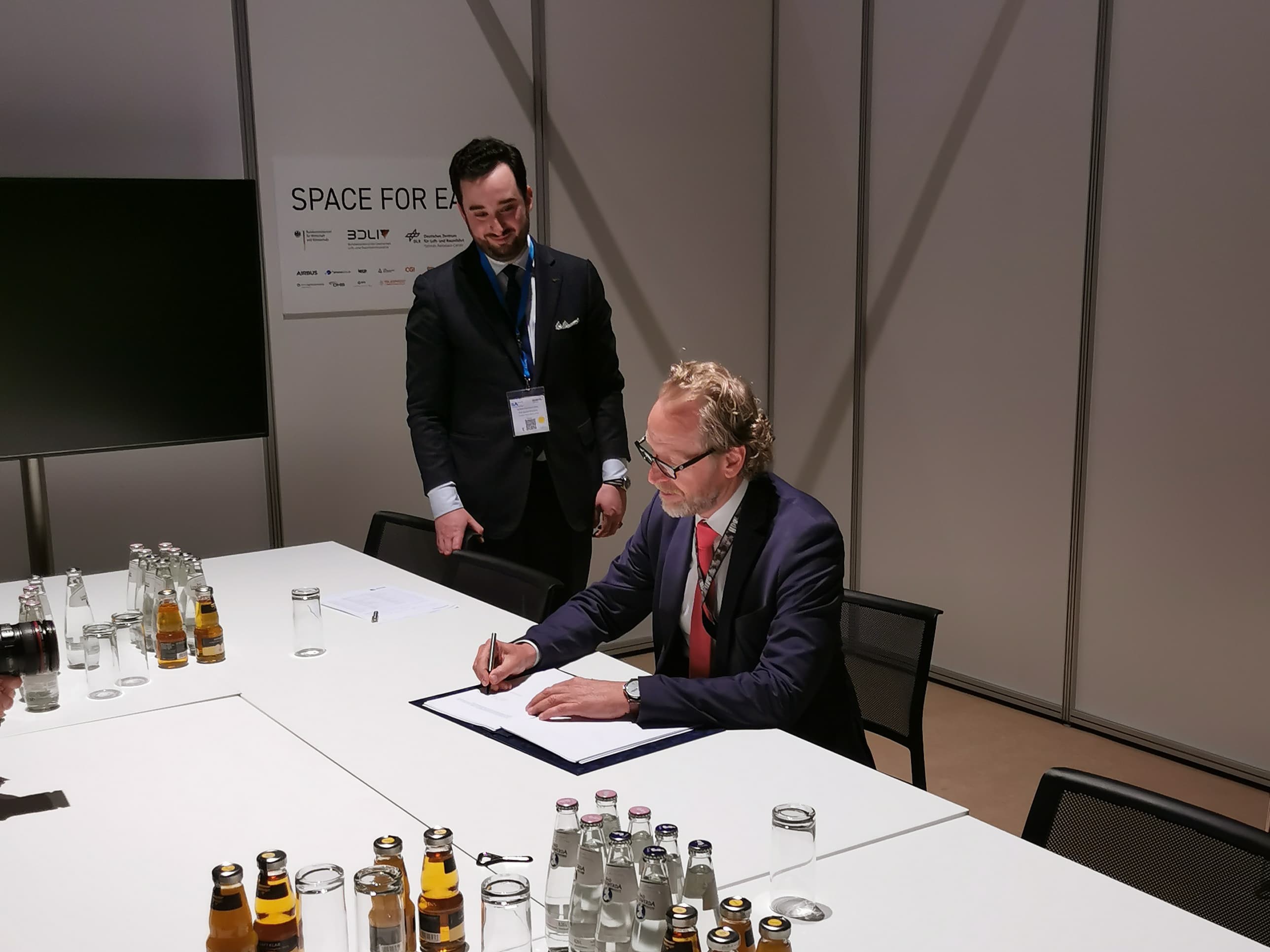
Historic Moment: 12 Nations Sign the Zero Debris Charter
The Charter was signed in Brussels on May 22 by 12 countries, including Germany. Since then, over 100 organizations, companies and entrepreneurs have been waiting for their cue to sign.
The ILA 2024 marks a very important stage on this path towards the sustainability of European space travel and sets an example for companies on other continents.
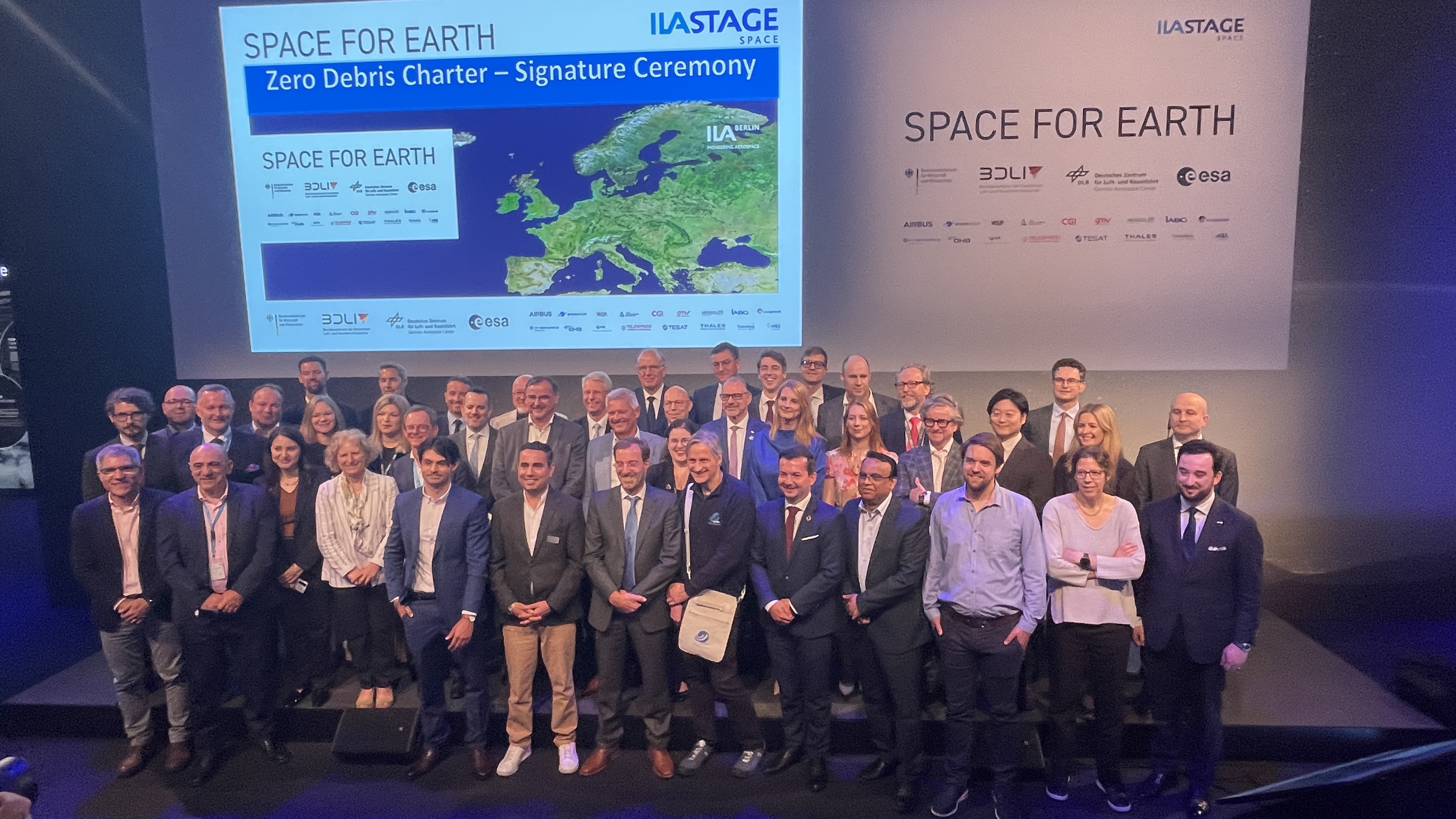
April 2024
Key Note by HPS-CEO Ernst K. Pfeiffer; ESA-ECSL Zero Debris Future Symposium, ESOC, Darmstadt, 04.04.2024.
ESA Zero Debris Future Symposium, Darmstadt
Opportunities from Implementing a Zero Debris Vision for Europe
Dear Director Densing,
dear Holger, dear Quentin,
dear colleagues from agencies, industry, research and development.
1. INTRODUCTION
It is always difficult to sell it to the general public as an “opportunity” when new regulations come into force. New rules always have something to do with restrictions, with control, with costs on all sides.
Well, let me talk about DIRECT and INDIRECT opportunities in relation to a “Zero Debris Vision”, even if I will sometimes use critical words.
2. DIRECT and INDIRECT Opportunities.
Yes, there are a number of companies for whom the
“Zero Debris Approach” could be a very promising DIRECT opportunity. The list of business areas is not extremely long, but extremely interesting:
First of all, there are a number of different deorbit-technologies.
In recent years, ESA has unfortunately only mentioned to the public the ACTIVE removal of EXISTING large junk. However, it will still take many years before 1,000 items per year can be removed commercially.
But there are already some deorbit-kits for satellites that MITIGATE debris before being created: chemical engines (MBDA, De-Orbit), electric propulsion (Morpheus), tether systems (Sener), or deployable drag sails (e.g. from my company HPS), already with TRL9. The winner-technologies will be those a) that will work, even if the satellite fails, b) that do not shorten the mission time, and c) that are emission-free.
Other business opportunities include debris measurement, debris software models, accurate position determination, collision prediction service, automatic collision avoidance systems, deorbit prediction software, or demise calculation software. All this is creating great opportunities for SMEs, the supplier industry and for service models. In the future there will also be a market for certifiers (a kind of “TÜV” for launch permission), for insurance companies, lawyers and much more.
Now to the INDIRECT opportunities, they are very simple: If we do nothing, there will soon be a collision-domino in LEO, a catastrophe. That’s it. No more space business, we all can close our companies, “Game Over”.
Anyone who hasn’t recognized this can no longer be helped. In this respect, the “Zero Debris Charter” is an extremely important sign to European space players. It will also motivate many countries to introduce appropriate measures.
Surprisingly, but understandably, the newer, small space states that want to do missions by themselves, are at the forefront. A recent article wrote: “Experts at the United Arab Emirates Space Agency are urging global decision-makers to put space debris mitigation at the top of their agenda.”
3. How do direct opportunities become a reality for Europe?
In the short term, opportunities become only reality, if European regulations become binding, when sanctions and fines are threatened. Why should a satellite builder spend extra money on deorbit-technology, if he doesn’t have to?
Catalysts in cars were also only installed, when regulations were set in place.
Of course, regulations must not put European providers at a disadvantage on the global market. And first regulations must be easy to understand and easy for the industry to implement.
Tell a politician: “The casualty risk from re-entering objects should remain lower than 1 in 10,000”…
When I was in February in Vienna at the United Nations Workshop on “Longterm Sustainability of Outer Space Activities”, I promoted on the podium in front of many states the simple “5-years deorbit rule”…; all UN-delegates easily understood it.
Or tell today a motivated satellite start-up: “The probability of space debris generation through collisions and break-ups should remain below 1 in 1.000 per object during the entire orbital lifetime”.
How is he supposed to prove that? And who checks that?
Other non-European countries have also recognized the opportunities. In mid-February there was a “Space Debris Workshop” in Saudi Arabia, where countries from all over the world exchanged ideas about the opportunities.
Opportunities in a global market require massive investment and speed, and some countries will provide it. If we are not attentive here in Europe, the world will overtake us.
Or do we want great European ideas/companies to be bought up by non-European companies?
For doing the very big things, small companies will have little chance.
20 years ago, there were hundreds of online delivery services, now there is basically only Amazon.
20 years ago, there were hundreds of online dating sites…now there’s basically only Tinder left in the world’s connection.
Seriously, when it comes to “sustainable space”, it is primarily the responsibility of states and agencies to introduce it into their missions and, at the same time, to accept respective increased mission costs.
It is a political task not to become dependent on technologies and services, when new regulations are introduced. If you also strive for leadership, appropriate financing and support of the big and small companies are necessary;
we in Europe cannot only rely on venture capital alone, especially when it comes to the issue of zero debris.
(And, on this occasion, leadership doesn’t work with a 30 hours-week or retirement at 60.)
The salvation doesn’t come only with the start-ups either. We in Europe need a healthy mix of established companies and start-ups, depending on the task. We’re still talking about space missions, with technology at the limits of feasibility. You need experienced specialists to achieve success. Global collaborations are helpful for large tasks.
(All the best for you, ASTROSCALE, a cooperation in 3 continents.)
That leads me to the next point, some
4. MEDIUM-TERM TECHNOLOGY PRIORITIES
Three examples from my point of view:
1) If I had real money
(and if I also wanted to see large parts of the world dependent on me),
I would build a GIGANTIC system of debris monitoring, with the largest AI-based database. I would sell this data, with an additional warning system as an option….
It exists already? Yes, I know, but only for larger junk, larger than 10 cm.
In the next 3 to 5 years the small particles, even smaller than 1 cm, will become the greatest unknown danger. They will multiply in a domino system, come in swarms and endanger entire constellations.
I would have a fleet of LEO observation satellites (with their own deorbit kit, of course) operating with different sensors, measuring directly in orbit impacts 24/7 and letting the AI do the rest.
There are already a few ESA-approaches to this in the Space Safety Program, but unfortunately only with underfunded studies; still.
2) Autonomous anti-collision-subsystems for autonomous flying.
A global market for small modules, buyable to everyone.
Will Europe be ahead here? Technologically and price-wise?
3) What is missing is a comprehensive software to predict, whether a satellite will burn completely or not. Because anyone who cannot prove this, especially for satellites >200 kg, must (according to the Zero Debris Charter) perform a controlled (and therefore expensive) re-entry over the seas.
Satellite builders prefer to buy certified software.
However, this software must be affordable, otherwise only large companies can afford it and that cannot be the goal of a Zero Debris initiative.
5. But what should be done NOW, IN THE SHORT TERM?
1) The 25 years deorbit rule dates back to the Middle Age, but is still firmly anchored in most minds. I strongly recommend that the rule:
“Deorbit within 5 years after end-of-business”
will be introduced immediately for all ESA missions into LEO and that this will be communicated publicly from the highest level, e.g. right after signature of the Zero Debris Charter.
2) Neither ARIANE 6 nor VEGA may carry any more satellites into LEO, that do not follow this rule.
Elon Musk is showing the world: from October onwards, there will no longer be permission for environmental sinners to fly on FALCON 9.
3) Each satellite should have retroreflectors on board to enable accurate tracking from the ground.
4) Financial vouchers should be awarded by ESA to companies and universities that install zero debris technologies on their satellites.
5) Director Densing, if European countries are serious about environmental awareness and “Clean Green Space”, the Space Safety program at CMIN 2025 must be significantly increased.
6. FINISH
So, I think that’s enough powder for a lively panel discussion.
For now, thank you very much for your attention.
September 2023
Erster September – der Herbst steht vor der Tür. Fallen werden bald die Blätter, so wie jedes Jahr. Fallen werden auch Entscheidungen, wie etwa über den nächsten Bundeshaushalt – ebenfalls wie jedes Jahr. Zum ersten Mal aber in der Geschichte der Raumfahrtpolitik drohen diese Budgetentscheidungen besonders jene Teile der Raumfahrtindustrie zu Fall zu bringen, als deren weiße Ritter sich die verantwortlichen Politiker in der Öffentlichkeit aller Wirklichkeit zum Trotz unverdrossen weiter präsentieren: Raumfahrt zum Schutz für die Erde und zum Nutzen der Menschen, wirtschaftliche Stärkung von Innovation durch den Mittelstand, Euphorie bei der Neugründung von Startups und nicht zuletzt den strategischen Wunsch Deutschland als starken Partner in der Weltwirtschaft und -politik zu behaupten.
Für diese Ziele schaltet die Ampel in Berlin aber nicht nur allein durch geplante Budgetkürzungen auf Rot: Mit den schon im April für die Diskussion im Herbst aufgemalten Eckpunkten einer neuen deutschen Raumfahrtstrategie, über die ebenfalls im Herbst beschieden werden soll, deutet sich unumkehrbar ein negativer Paradigmenwechsel in der Wirtschaftspolitik zur Raumfahrt an: da, wo „Resilienz“ gefordert wird, mit fliegenden Fahnen hin zur Großindustrie, da, wo „Exzellenz“ gezeigt werden soll, hin zur weiteren Stärkung der Staatsinstitutionen, dort, wo „Souveränität“ gefragt ist, im Eilschritt hin zum Fortdelegieren von Zielsetzung und Programmführung unter den Rocksaum der mächtigen EU. Und die deutsche Raumfahrt profitiert von noch mehr Engagement der Politik: Die für jede politische Sonntagsrede ach so wichtigen Startups erhalten kostenlosen Nachhilfeunterricht im Umgang mit der Bürokratie und ihren Antragsformularen, die Forschungslandschaft wird effektiver durch bessere Vernetzung, und KMU, die Kraft aus der Mitte? Sie erhalten Unterstützung auf neuem Niveau – moralisch. Oder wie sollte sonst eine Budgetkürzung bei einer weltweit anerkannten Zukunftstechnologie und -fähigkeit (z.B. die Beteiligung an Infrastrukturthemen wie für eine europäische satellitengestützte Kommunikation IRIS²) mit einer Neuauflage einer Raumfahrtstrategie zusammenpassen?
Offenbar sollen also nun beide Handlungsstränge, das Kürzen des Raumfahrtbudgets und die neue, ausdrücklich für jedwedes Budget passende Raumfahrtstrategie harmonisch bei der Gestaltung der künftigen Raumfahrt-Wirtschaftspolitik zusammenwirken. Das Ganze so gekonnt formuliert, dass der flüchtige Leser meinen könnte, es ginge voraus in die helle Zukunft und nicht zurück ins dunkle Mittelalter der Raumfahrtpolitik.
Noch ist es nicht so weit, und damit es auch nicht so weit kommt, hat Ernst K. Pfeiffer in seiner Funktion als Sprecher des Raumfahrt-Mittelstandes (AKRK und Best of Space) zusammen mit deren Mitgliedern noch im Juli einen offenen Brandbrief im Namen der engagierten deutschen Raumfahrt-KMU und Startups direkt an den Bundeskanzler Olaf Scholz geschrieben und zudem das Angebot von Finanzminister Christian Lindner zum Dialog im August angenommen, um auf die drohenden Gefahren wirtschaftlicher und strategischer Verluste hinzuweisen.
October 2015
On September 30th, HPS welcomed a VVIP-delegation of German and Bavarian space policy at its HQ-premises in Munich. Dr. Gerd Gruppe, head of space management and member of the executive board of DLR was accompanied by DLR´s head of SME-policy, Uwe Soltau, and Bernd Buchenberger, Senior Manager space and aerospace at the Bavarian ministry of economy.
Munich as well as Berlin pay special attention to the sector of space-SME, since SME are expected to serve as pacemakers in the first front of technological innovation. In this respect, space-tech expert HPS is especially in focus, since the company is the only German SME with a subsidiary in Europe representing today the long vacant position of the „M“ in space-SME. In addition, its managing director and owner Dr. Ernst Pfeiffer acts towards politics and business as spokesman of all German space SME organized in the AKRK-Committee.
Accordingly, the delegation was especially interested in the company´s new ready-to-market products – innovations which play a vital role in the German space agency´s new „component initiative“ – as well as in first hand information about important aspects of international cooperation like between HPS Germany and its subsidiary HPS Lda., Portugal.
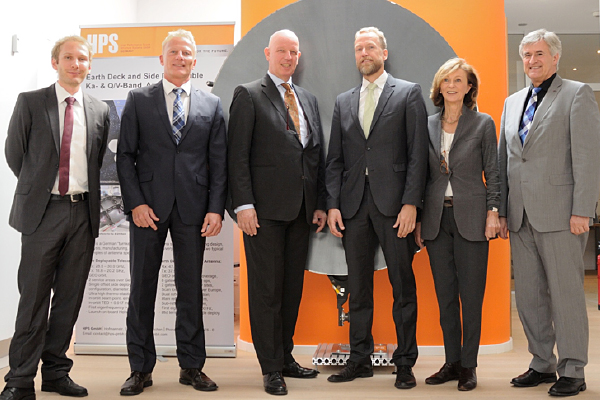
Dr. Gruppe personally pushes the German „component initiative“ with high priority in the firm belief that the German space industry urgently needs to define its own answers to challenges arising from the advent of completely new players like Google on the hitherto „closed shop market“ of space technology. According to Gruppe, „components“ form the central element: small, serially produced, very cost effective, and innovative units which more than ever before allow space to become an integrative and pacemaking part of daily life in business and society.
Together with HPS shareholder Sigrid Klett, former co-owner of the Munich based space company Kayser-Threde, Ernst Pfeiffer introduced the latest HPS-developments, like
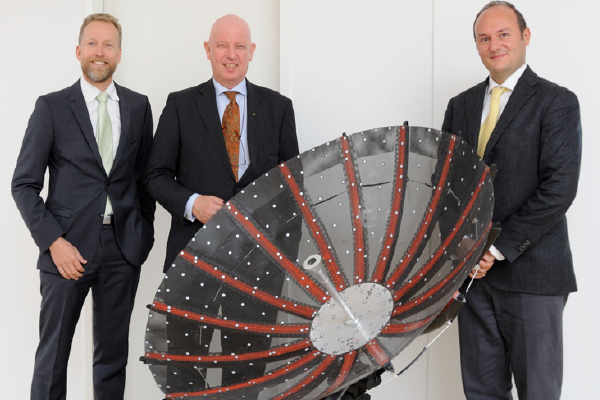
Peter Rauhut, CFO and also co-owner of HPS finally presented the full picture of the business situation of the enterprise growing at high speed since its foundation 15 years ago. In particular, he outlined the enormously positive growth impulses generated by the successful MLI-production of the Portugese subsidiary.
Ernst Pfeiffer outlined the importance of combining a top-quality serial production in Portugal at prices unparalleled with continuous development of new products in Germany in order to win and keep the support of banks accompanying the company´s growth even at fast pace. He also stressed the fact that the obviously strong support by politics in Bavaria and Berlin serves as yet another important cornerstone of trust towards HPS in the financial sector. There is enough room for yet further growth through innovations that lead to serially manufactured products, as an example Pfeiffer hinted at a soon upcoming development of GTO-satellite antennas for the transmission of Galileo-data.
Impressed by the dynamics, the technology and the company culture at HPS the delegation agreed to arrange for successive meetings on yet more detailled subjects in the near future.
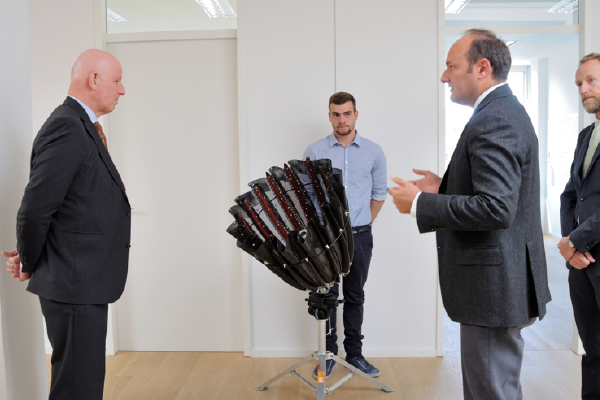
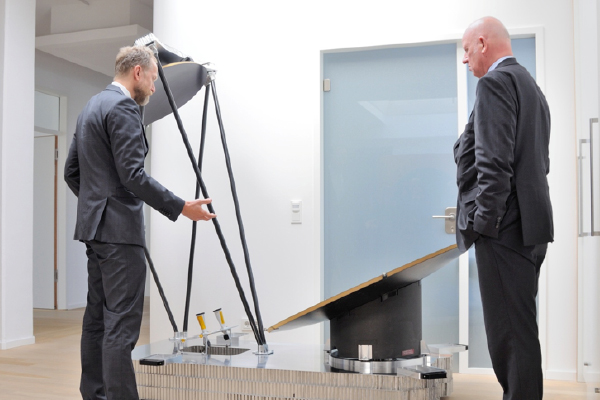
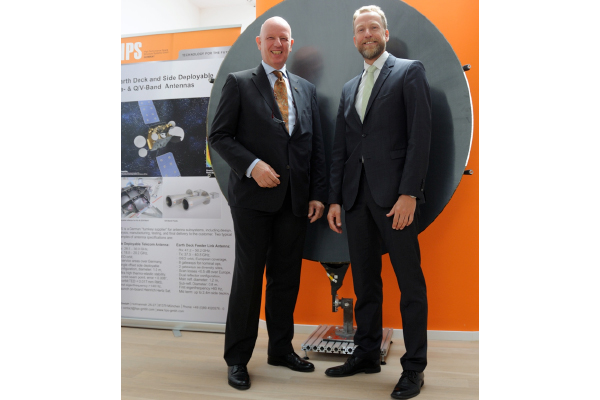
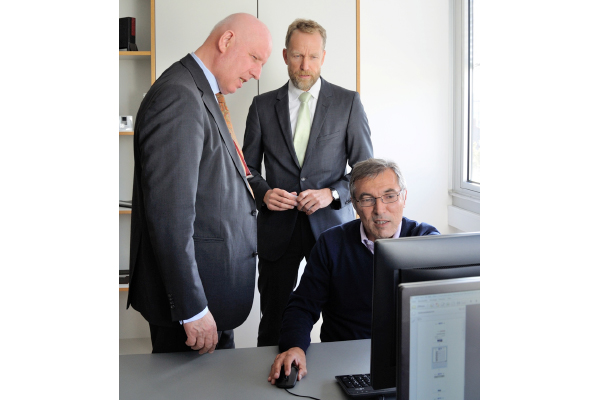
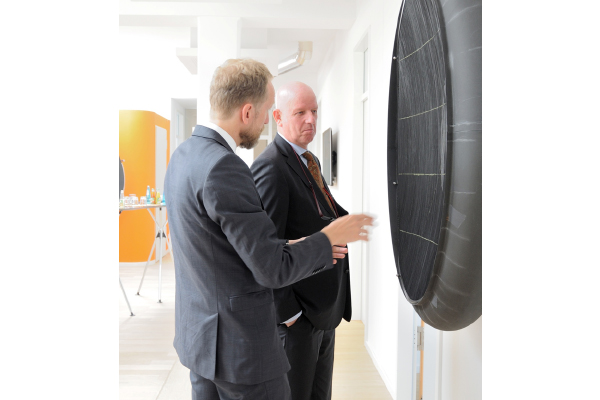
October 2014
On 11.10.2014 the Chief Executive Officer of HPS GmbH, Germany, Mr. Ernst K. Pfeiffer, met the Portuguese Ambassador of Germany, Mr. Luis de Almeida Sampaio. In the frame of the 50th annual convention of the German-Portuguese Association DPG, Mr. Sampaio and Mr. Pfeiffer exchanged experience made and future visions of space related activities. It was highly acknowledged that the German-Portuguese joint venture, HPS Lda., Porto, the subsidiary of HPS GmbH, Munich, develops very successfully and grows rapidly and that already in 2016 flight hardware made in Portugal will be launched to Mars on board the European mission ExoMars. HPS Portugal is producing here so called Multilayer Insulation for some scientist instruments and in addition for the complete Entry and Descent Module EDM.

June 2016
Space-News:
In den letzten Wochen und Monaten haben Sie als Sprecher der deutschen Raumfahrt-KMU einen Marathon der Veranstaltungen in Vorbereitung der ESA-Ministerratskonferenz absolviert. Kam diese plötzliche Berücksichtigung der Raumfahrt-KMU durch die Institutionen für Sie überraschend?
Pfeiffer:
Keineswegs. Zum einen haben wir in den vergangenen Jahren sehr stark drauf hingearbeitet, dass unser AKRK-Zusammenschluss der rund 40 von insgesamt 90 Raumfahrt-KMU mit ca. 1500 von insgesamt 2500 Beschäftigten in Deutschland endlich als einziger unabhängiger Ansprechpartner des Mittelstandes zur Kenntnis genommen wird. Und sicher hat auch unsere kumulierte Darstellung von Kompetenz, Wirtschafts- und Innovationskraft in der kürzlich vorgestellten Website „Best-of-Space.de“ dazu beigetragen. Wir sind in der Tat auf Augenhöhe mit den Großen der Branche von ESA und deutschem Wirtschaftsministerium berücksichtigt worden. Das galt zwar schon zum High Level Forum der ESA im Juni letzten Jahres, startete aber dieses Jahr intensiv mit einem Vortrag über das Technologieprogramm vor den ESA-Delegierten am 9. Mai, ging über ein Top Level Gespräch über die ESA Strategie zwischen ca. 10 CEOs der europäischen Raumfahrtfirmen und ESA-Generaldirektor Herrn Wörner mit allen seinen Direktoratschefs am 12. Mai, weiter zur Panelveranstaltung „New Space“ am 2. Juni auf den Space Days der ILA in Berlin und schließlich zum diesjährigen High Level Forum der ESA am 20. Juni auf dem ich im Panel über „Next Steps for ESA“ eingeladen bin.
Space-News:
Alle reden von „new space“ ….
Pfeiffer:
Genau, alle reden über „new space“ – und meinen in Ermangelung eines europäischen Weges den amerikanischen, der da lautet: „machen, was finanzkräftige Quellen haben wollen“ und „mit privatem Risiko finanzieren, und wenn es schief geht werde ich auch nicht arm woran man selber glaubt“
„Masse über Klasse stellen und dabei Qualitätsverluste in Kauf nehmen, solange sie sich zumindest kurzfristig rechnen“.
Space-News:
Ist das auch der europäische Weg?
Pfeiffer:
Niemand in Europa wird das unterschreiben. Zum einen, weil es diese finanzkräftigen Unternehmen in D und EU nicht gibt, ebenso wenig wie die Risikofinanzierer und schon gar nicht die Mentalität, nicht nachhaltiges Billiges zu bauen, dabei Qualität zu opfern und Folgekosten (Schrott etc) für kommende Generationen ohne Ansicht der Dimension in Kauf zu nehmen.
Abgesehen davon, ist es ein gewaltiges Risiko, sich darauf zu verlassen, dass schon genügend reiche Unternehmen aus den USA auf Ideen kommen, wie sie denn durchgehend die Raumfahrtindustrie in Europa beschäftigt halten können.
Space-News:
New Space in diesem amerikanischen Sinne ist also weder europäisch, noch ist es geeignet, gerade KMU eine Perspektive zu geben?
Pfeiffer:
New Space europäischer Machart wäre das Ergebnis auch europäischen Vorgehens und Denkens. Und da haben wir eine Menge aufzuweisen. Wir machen nicht einfach mal eben so etwas, weil es vielleicht hier oder da kurzfristig Gewinn bringt – wir machen überhaupt nichts nur nach dem reinen Prinzip kurzfristigen ökonomischen Gewinns. Wir machen die Dinge in Europa so wie wir sie machen, weil für uns hier die Dinge immer einen viel tieferen Sinn und Nachhaltigkeit, als kurzfristig in Dollar messbar ergeben müssen. Ziel in Europa war es bisher, nicht nur eine Handvoll reicher Unternehmen noch reicher zu machen, sondern möglichst viele Unternehmen nachhaltig und langfristig zum Wohle einer unabhängigen, ausgeglichenen Gesellschaft zu erhalten. Derzeit besteht
Gefahr, dass dieses Gleichgewicht und die Unabhängigkeit in Europa kippt.
Space-News:
Wie drückt sich das aus?
Pfeiffer:
Lassen Sie mich ein Bild bemühen. Nach eben beschriebener amerikanischer Mentalität soll ein Produkt hinreichend funktionieren, nur Schäden für den unmittelbaren Nutzer müssen ausgeschlossen bleiben. Auch wir können uns sicher nicht alle der Faszination eines mächtigen V8 und dem Reiz vergleichsweise unendlichen Sitz- und Reisekomforts eines typischen US-Autos entziehen. Im Gegensatz zum Amerikaner nehmen wir es dann aber schon übel, wenn zugunsten eines schnelleren Verkauf garantierenden Preises dann unterwegs mal ein Knopf hier abfällt oder ein Schalter da nicht funktioniert. Und erst recht unakzeptabel ist für uns die Vorstellung von ressourcenvernichtenden Trinksitten und materialverschwendendem Design, was alles dann nur nachfolgenden Generationen Probleme macht. In Europa denken wir anders; Nachhaltigkeit hat für uns zwingend etwas mit Qualität zu tun. Darin sind wir gut, und darin sind wir besser als alle anderen – USA, Asien, Russland.
Space-News:
Was folgt daraus für „new space“ made in Europe?
Pfeiffer:
Wenn das so ist, sollten wir das auch zur Grundlage unseres „European way of new space“ machen. Nicht warten, bis irgendwer von irgendwo irgendeinen kommerziellen Auftrag platziert, sondern die Landschaft solcher Aufträge samt Staat, Auftraggebern, Programmen und Auftragnehmern selbst vorzeichnen.
Wenn wir als KMU politik- und öffentlichkeitswirksam dieses Feld der systematischen Suche nach vernünftigen, nachhaltigen und politisch wie wirtschaftlich höchst wünschenswerten „new space – Projekten made in Europe“ besetzen, besetzen wir damit gleich das ganze Feld „new space“ selbst und jegliche Diskussion darum. Wir stellen solide Weichen, statt blind Trittbrett zu fahren!
Space-News:
Kann das wirklich in Anbetracht der „unendlichen Möglichkeiten“ jenseits des Atlantiks funktionieren?
Pfeiffer:
Sicher kann es das, und ich bin darüber hinaus sicher, dass es seine Wirkung auf den „American way of new space“ auch nicht verfehlen wird. Nehmen Sie wieder das Bild vom Auto. Wie kommt es wohl, dass amerikanische wie auch japanische Hersteller in den letzten rund zwanzig Jahren vermehrt dazu übergehen, europäisches Design, und europäische Technik und Europäisches Umweltbewußtsein als Maßstab mitzunutzen? Das Bessere ist des Guten Feind, das wird auch bei „new space“ auf lange Sicht nicht anders sein.
Space-News:
Ist das Ihre Hauptbotschaft auf dem Marathon zur Ministerratskonferenz?
Pfeiffer:
Das und der dringende Hinweis, dass wir beim Hype um „new space“ unseren „old space“ nicht vergessen sollten, sprich: weiterhin Investition in Höchst-Technologie. Gerade wir Deutschen sind ja oftmals so eifrig dabei, neue Dinge – besonders, wenn sie aus den USA kommen – über das Bestehende zu stellen. Davor kann ich nur warnen. Bei aller Begeisterung für Neues – die liegt ja auch irgendwo in der menschlichen Natur – das zu vernachlässigen, was uns in der Raumfahrt groß gemacht hat, endet für uns im Desaster, in einer verlorenen Unabhängigkeit Deutschlands. Um abschließend noch mal den Autofahrer-Blick einzunehmen: Wenn wir mit unausgegorener Taktik, mangelnder Schnelligkeit und unzureichender (Finanz-) Kraft auf die linke Spur wechseln, um einer Chimäre nachzujagen, müssen wir uns nicht wundern, wenn uns traditionelle, staatsgetriebene Old-Space-Länder Europas und Asiens auf der Pannenspur technologisch überholen. Als Raumfahrt-KMU werden wir jedenfalls schön weiter hochinnovativ die technologische Mitte besetzen und von dort aus versuchen, flexibel mit neuen, kreativen Ideen von Anwender-KMU den „European Way of New Space“ zu leben.
Eine zweite Botschaft an die Ministerratskonferenz wäre noch: Nutzt die aktuelle Begeisterung für Raumfahrt in der Gesellschaft für Inspiration, europäischen Zusammenhalt, globale Zusammenarbeit und damit Friedenssicherung.
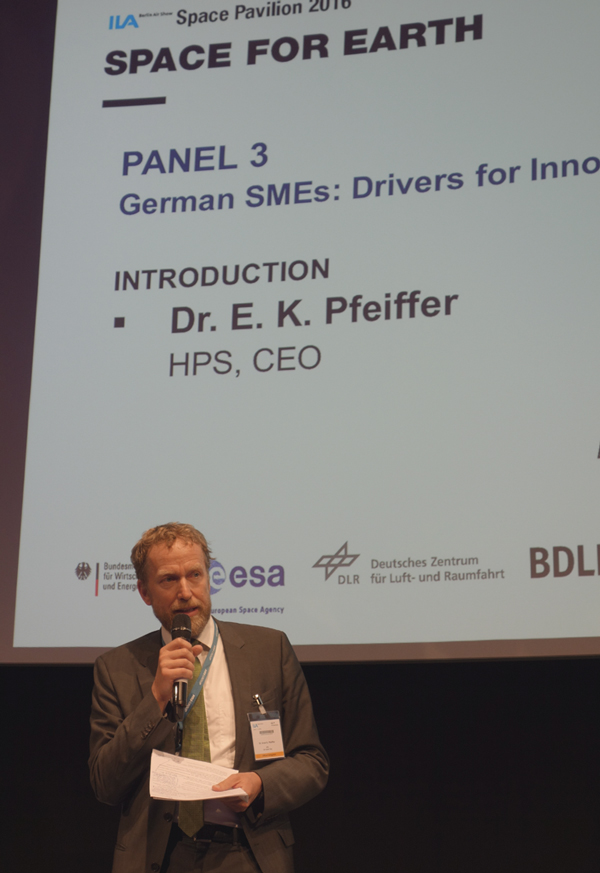
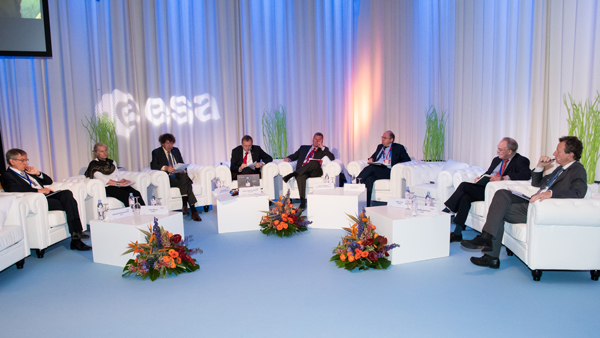
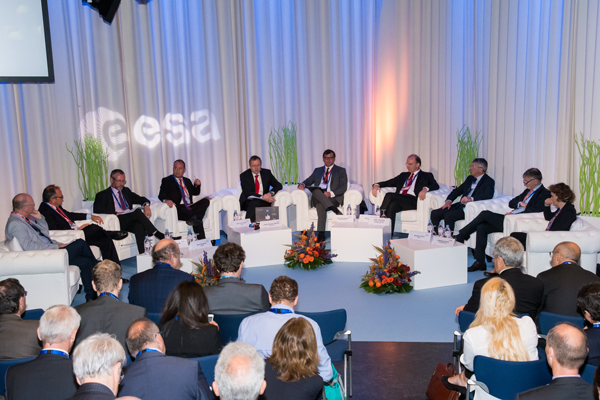
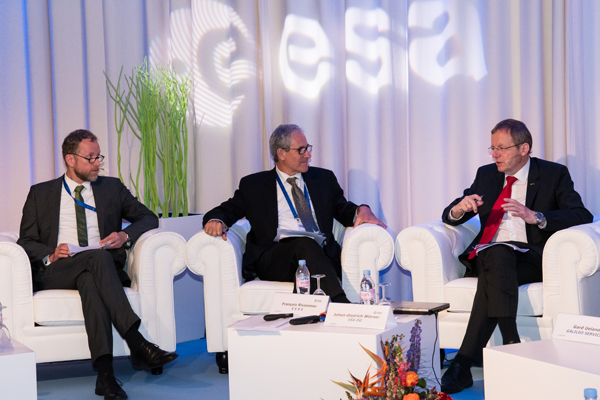
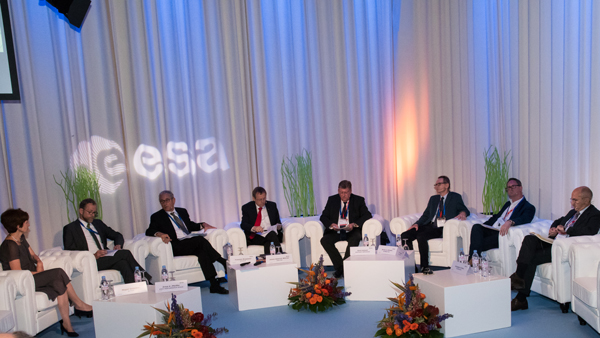
October 2017
„Technology“ means „knowledge how to solve problems by applying technical solutions“. In the absence of abundant natural resources technology is nothing less than the key to self‐determination and liberty as the highest societal value in a free world.
Therefore, the European Commission (EC) dedicates with high priority comprehensive programs to …“
More information can be found in the LEA_Press_Release_1 and in the article of Space Intel Report
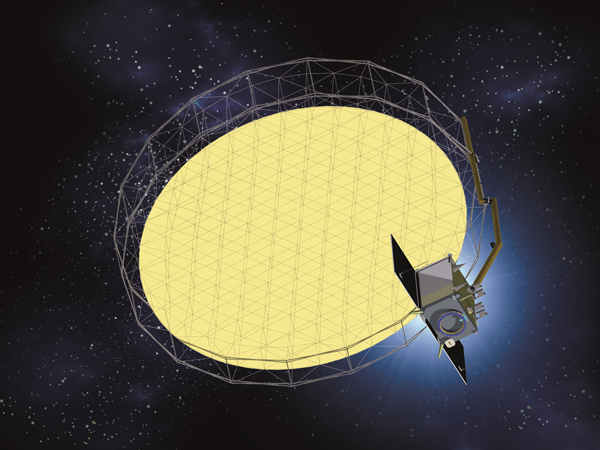
April 2019
Am 18. April 2019 besuchte Thomas Sattelberger (FDP), Bundestagsabgeordneter des Wahlkreises München Süd, den Raumfahrt-Mittelständler HPS. Als ausgewiesener Innovationsexperte interessierte er sich dabei vor allem für die vom deutschen Raumfahrt-Mittelstand ausgehenden Impulse für neue Technologien, mit denen Europa im Rahmen von EU und ESA seine Unabhängigkeit von Zulieferungen und Wohlwollen seitens der Konkurrenz anderer Kontinente gerade in kritischen Bereichen erkämpft.
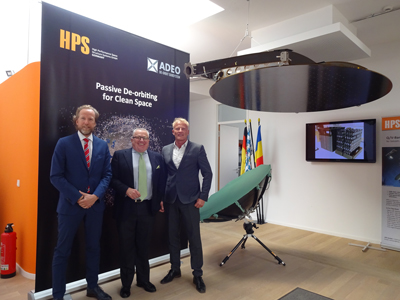
Gerade auf diesem Gebiet hat HPS jüngst zwei bahnbrechende Erfolge zu verzeichnen: Die Entwicklung des HPS-Bremssegels ADEO zur schnellen Entsorgung ausgedienter Satelliten hat vor wenigen Monaten seinen Feuertest im All mit Bravour bestanden, und vor wenigen Tagen gewann ein von HPS geführtes Konsortium von 17 meist mittelständischen Raumfahrtunternehmen aus sechs Ländern gegen große Konkurrenz den Entwicklungsauftrag für die künftige große entfaltbare Antennentechnologie Europas mit Einsatzgebieten von Erdbeobachtung über Big Data und das Internet of Things bis hin zu militärischen und Telekommunikationsanwendungen.
HPS-CEO Dr. Ernst K. Pfeiffer nahm die Gelegenheit wahr, die Bedeutung des Ausbaus von Technologie-Programmen für die Raumfahrt-Zulieferindustrie auf nationaler und europäischer Ebene gerade auch für die Ermöglichung der Teilnahme an den steigenden internationalen Märkten und damit verbunden die Jobmaschine der Raumfahrt-KMU hervorzuheben. Die ESA Ministerratskonferenz 2019 liefert dafür die beste Gelegenheit, um sowohl die ESA-Technologieförderung über die Programme ARTES und GSTP sowie auch die deutsche Beteiligung am EU-Programm Kopernikus nachhaltig zu stärken. MdB Thomas Sattelberger bestätigte die enorme Bedeutung der Raumfahrt als Anwendung für die Menschen auf der Erde wie auch als Technologietreiber für andere Wirtschaftsbereiche. Seine Expertise hatte er selbst in langjähriger Arbeit im Bereich der bayerischen Luft- und Raumfahrttechnik gewonnen, bevor er nach seiner Position als Vorstandsmitglied bei der Deutschen Lufthansa und seiner letzten beruflichen Station als Vorstandsmitglied der Deutschen Telekom für die Freien Demokraten in den Bundestag einzog.
June 2019
Flug nach München. Gemeinsamer Termin mit meinem Parteifreund Wolfgang Heubisch MdL, Bayerischer Wissenschaftsminister a.D., heute Landtagsvizepräsident und forschungspolitischer Sprecher der FDP im Bayerischen Landtag.
Mit dabei Maria Herrmann, Büroleiterin meines Berliner Fraktionskollegen Mario Brandenburg. Wir besuchen Raumfahrtmacherinnen und -macher im Münchner Süden, die HPS GmbH. Für mich bereits der zweite Besuch.
Am 20. Juli vor 50 Jahren wurde John F. Kennedys Vision „We choose to go to the Moon” Wirklichkeit.
Dazu planen wir was. Was? Sage ich nicht. Könnte ja auch sein, dass wir ob der Berliner Arbeitslast vorher in die Knie gehen.
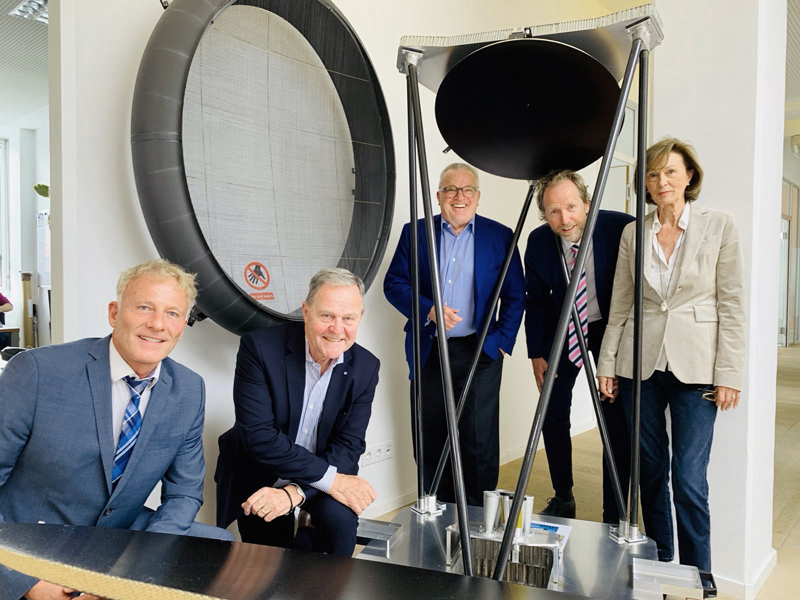
July 2019
Inhalt der Veranstaltung war die Diskussion eines neuen Kurses für die deutsche Raumfahrt mit abschließender Präsentation von 7 Forderungen an die bayrische Landesregierung und die Bundesregierung.
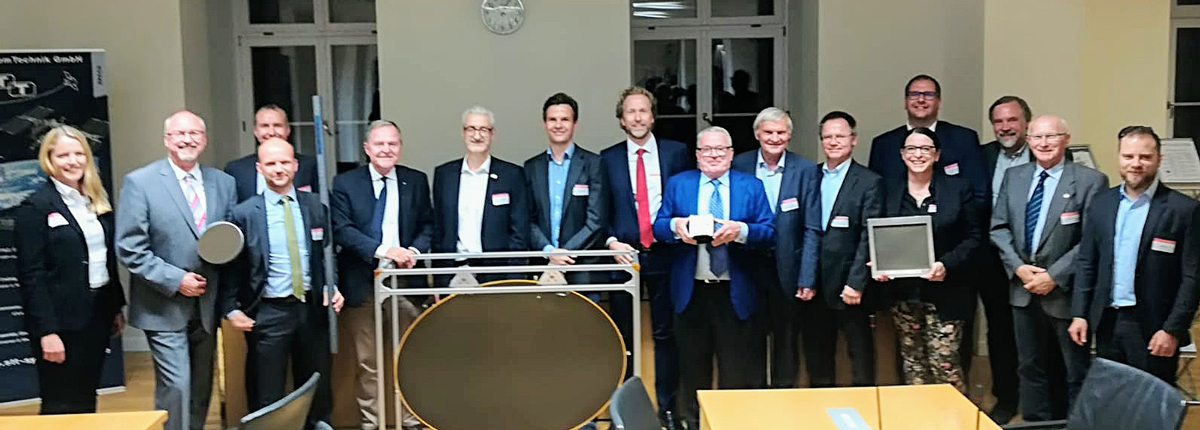
50 Jahre nach der Mondlandung: Wie sind Deutschland und Bayern aufgestellt bei der Zukunftstechnologie Raumfahrt? Wo liegen die größten Chancen? Wo besteht Handlungsbedarf? Wo muss die Politik mit Hand anlegen und unterstützen?
Veranstalter:
